Today’s Important Articles for Pub Ad (05-04-2022)
WSDP Bulletin (05-04-2022)
(Newspapers, PIB and other important sources)
Prelim and Main
- Jagannath Puri Temple READ MORE
- ‘Govt committed to develop sports infrastructure in J&K’ READ MORE
- 53 airports are included under Krishi Udan Scheme READ MORE
- Linking Of Five Rivers READ MORE
- Amendment In Easements Act, 1882 READ MORE
- Explained: What is the IPCC, and why are its Assessment Reports important? READ MORE
- All about India-Australia Economic Co-operation and Trade Agreement READ MORE
- Almost everyone now breathing polluted air, warns WHO READ MORE
Main Exam
GS Paper- 1
- More suicides than murders: Society sensitised to mental ills key to addressing problem READ MORE
- Here are five ways to counter groundwater depletion in the Ganga basin READ MORE
GS Paper- 2
POLITY AND GOVERNANCE
- Push the policy needle forward on migrant support READ MORE
- Criminal Procedure bill will not make Indians safer READ MORE
- Politics of freebies: States and political parties aren’t realising the cost of fiscal spend on giveaways READ MORE
SOCIAL ISSUES AND SOCIAL JUSTICE
- In 2022, let’s create gender-positive learning spaces READ MORE
- Safeguard LGBT people from bias READ MORE
- The Need to Address Caste Discrimination and Atrocities as Collective Trauma READ MORE
INTERNATIONAL ISSUES
- The road to Ukraine peace runs through Delhi READ MORE
- Ambedkar, Nehru, and Atmanirbhar Bharat READ MORE
GS Paper- 3
ECONOMIC DEVELOPMENT
- Time for RBI to end its ‘take it easy’ policy READ MORE
- Limited gains: India should review its position on RCEP READ MORE
- Renewable energy to climate action — how India can achieve sustainable development in 2022 READ MORE
ENVIRONMENT AND ECOLOGY
- IPCC: World Must Halve Emissions by 2030 READ MORE
SECURITY
- The Withdrawal of AFSPA in Parts of Northeast Changes Little on the Ground READ MORE
GS Paper- 4
ETHICS EXAMPLES AND CASE STUDY
Questions for the MAIN exam
- “Speak when you are angry and you will make the best speech you will ever regret” – Ambrose Bierce.
- Policy in India often emerges from the ground up, taking decades to cement into national law and standard practice. Discuss with examples.
QUOTATIONS AND CAPTIONS
- When we change the way we communicate, we change society.
- Rapid decarbonization of energy is non-negotiable if we are to avert catastrophic global heating, says the latest UN climate report.
- If India wants the best of both worlds, it must step up and live up to its claim of becoming a ‘Vishwa-Guru’ (or world leader).
- Amidst the scattered experimentation now, the Centre must offer strategic policy guidance for inter-State coordination.
- The criminal Procedure bill empowers police and governments to conduct such intrusive investigations with little accountability and few legal guidelines.
- Grumblings about dollar dominance aren’t new. But even if Russian sanctions lead to some non-dollar trade & some crypto payments, dollar will remain a safe haven asset.
- State governments can have great impact on safeguarding LGBTQIA+ communities from bias, and one hopes that the intent behind these bills will be reflected in the everyday policies of administrations run in these states.
- A society sensitised towards the mentally afflicted persons can help prevent suicides.
- A common test for admission into Central Universities might just now seem appealing, but it could heavily impact learning in the long run
- A clean energy transition can improve the quality of life of rural communities, especially for women. It could improve healthcare and education and facilitate a host of local economic activities to create new jobs.
- While it is true that AFSPA in Assam not as heavy-handed as in Manipur and Nagaland, it is worth recalling that there was never an assurance to a commoner in Assam either that they would not be unfairly impacted by the draconian law.
50-WORD TALK
- As Russian foreign minister Sergey Lavrov lobbies India to defy Western sanctions, emissaries for London and Washington have asked Delhi to reduce ties with Moscow. Delhi must assert its interests without becoming entangled in a superpower brawl. There’s no prize for standing tall in the middle of someone else’s firefight.
Things to Remember:
- For prelims-related news try to understand the context of the news and relate with its concepts so that it will be easier for you to answer (or eliminate) from given options.
- Whenever any international place will be in news, you should do map work (marking those areas in maps and exploring other geographical locations nearby including mountains, rivers, etc. same applies to the national places.)
- For economy-related news (banking, agriculture, etc.) you should focus on terms and how these are related to various economic aspects, for example, if inflation has been mentioned, try to relate with prevailing price rises, shortage of essential supplies, banking rates, etc.
- For main exam-related topics, you should focus on the various dimensions of the given topic, the most important topics which occur frequently and are important from the mains point of view will be covered in ED.
- Try to use the given content in your answer. Regular use of this content will bring more enrichment to your writing.
DAILY CURRENT AFFAIRS (APRIL 05, 2022)
THE POLITY AND GOVERNANCE
1. UNIFORM CIVIL CODE OF UTTARAKHAND
THE CONTEXT: Uttarakhand’s CM recently announced, that his government will implement the Uniform Civil Code in the state soon. The state cabinet unanimously approved that a committee of experts will be constituted at the earliest and it will be implemented in the state.
THE EXPLANATION:
The CM has claimed that it will boost equal rights for everyone in the state and enhance social harmony, boost gender justice and strengthen women empowerment.
What is UCC?
- The Uniform Civil Code (UCC) calls for the formulation of one law for India, which would be applicable to all religious communities in matters such as marriage, divorce, inheritance, and adoption.
- The code comes under Article 44 of the Constitution, which lays down that the state shall endeavour to secure a Uniform Civil Code for the citizens throughout the territory of India.
- It is intended to replace the system of fragmented personal laws, which currently govern interpersonal relationships and related matters within different religious communities.
What Do We Have Now?
- Different religious communities in India are currently governed by a system of personal laws, which have been codified over the years through various pieces of legislation.
- These laws largely focus on the following areas: Marriage and divorce Custody and Guardianship Adoption and Maintenance Succession and

- For example, Hindu personal law is codified in four bills: the Hindu Marriage Act, Hindu Succession Act, Hindu Minority and Guardianship Act, and Hindu Adoptions and Maintenance Act. The term ‘Hindu’ also includes Sikhs, Jains and Buddhists for the purpose of these laws
- Muslim personal law is not codified per se, and is based on their religious texts, though certain aspects of these are expressly recognised in India in acts such as the Shariat Application Act and Dissolution of Muslim Marriages Act.
- Christian marriages and divorces are governed by the Indian Christian Marriages Act and the Indian Divorce Act, while Zoroastrians are subject to the Parsi Marriage and Divorce Act.
- Then, there are more ‘secular’ laws, which disregard religion altogether, such as the Special Marriage Act, under which Inter-religion marriages take place, and the Guardians and Wards Act, which establishes the rights and duties of guardians.
- Furthermore, to protect distinct regional identities, the Constitution makes certain exceptions for the states of Assam, Nagaland, Mizoram, Andhra Pradesh and Goa with respect to family law.
- Goa is, at present, the only state in India with a uniform civil code.
- The Portuguese Civil Code of 1867, which continues to be implemented after India annexed the territory in 1961, applies to all Goans, irrespective of their religious or ethnic community.
2. 13 NEW DISTRICTS INAUGURATED IN ANDHRA PRADESH
THE CONTEXT: Andhra Pradesh officially created 13 new districts taking the total number to 26.
THE EXPLANATION:
How are new districts carved?
The power to create new districts or alter or abolish existing districts rests with the State governments. This can either be done through an executive order or by passing a law in the State Assembly. Many States prefer the executive route by simply issuing a notification in the official gazette.
How does it help?
States argue that smaller districts lead to better administration and governance. For example, in 2016, the Assam government issued a notification to upgrade the Majuli sub-division to Majuli district for “administrative expediency”.
Does the Central government have a role to play here?
- The Centre has no role to play in the alteration of districts or the creation of new ones. States are free to decide.
- The Home Ministry comes into the picture when a State wants to change the name of a district or a railway station. The State government’s request is sent to other departments and agencies such as the Ministry of Earth Sciences, Intelligence Bureau, Department of Posts, Geographical Survey of India Sciences and the Railway Ministry seeking clearance. A no-objection certificate may be issued after examining their replies.
THE INTERNATIONAL RELATIONS
3. BUDAPEST MEMORANDUM ON SECURITY ASSURANCES
THE CONTEXT: Budapest Memorandum on Security Assurances refers to three identical political agreements signed at the Organization for Security and Co-operation in Europe (OSCE) conference in Budapest, Hungary in 1994.
THE EXPLANATION:
About the memorandum
The Budapest Memorandum on Security Assurance, signed on December 5, 1994, sealed Ukraine’s membership in the NPT and its status as a non-nuclear country in return for security assurances. The signatories were the presidents of Ukraine, the US , Russia, and the British Prime Minister.
- The signatories of the memorandum agreed to provide security assurances to Belarus, Kazakhstan, and Ukraine in return for their accession to the Treaty on the Non-Proliferation of Nuclear Weapons (NPT).
- It came after the Lisbon Protocol of 1992, which made Ukraine, Belarus, and Kazakhstan parties to the first Strategic Arms Reduction Treaty (START I). It was a treaty signed by the US and the Soviet Union in 1991 to reduce the number of nuclear weapons.
- As a result of the agreements and the memorandum, between 1993 and 1996, Belarus, Kazakhstan and Ukraine gave up their nuclear weapons and became non-nuclear states.
- At that time, Ukraine had the world’s third-largest nuclear arsenal.
Signatories
- The memorandum was originally signed by three nuclear powers: Russia, the USA, and the UK.
- Later, China, and France, who became NPT members in 1992, also became signatories. However, they gave weaker individual assurances in separate documents.
Provisions
Russia, the US, and the UK agreed to the following:
- Respect Belarusian, Kazakh & Ukrainian independence & sovereignty in existing borders.
- Refrain from the threat or the use of force against Belarus, Kazakhstan, and Ukraine.
- Refrain from using economic pressure on Belarus, Kazakhstan, and Ukraine to influence their politics.
- Refrain from the use of nuclear arms against Belarus, Kazakhstan, and Ukraine.
- Seek immediate UN Security Council action to assist Belarus, Kazakhstan, and Ukraine if they “should become a victim of an act of aggression or an object of a threat of aggression in which nuclear weapons are used”.
About OSCE
|
THE ENVIRONMENT, ECOLOGY AND CLIMATE CHANGE
4. 99% OF THE WORLD’S POPULATION IS BREATHING POLLUTED AIR: WHO
THE CONTEXT: According to the data from the UN health agency showed that every corner of the globe is dealing with air pollution, although the problem is much worse in poorer countries. “Almost 100% of the global population is still breathing air that exceeds the standards recommended by the World Health Organization,”
THE EXPLANATION:
- In its previous report four years ago, WHO had already found that over 90% of the global population was affected, but it has since tightened its limits.
- “The evidence base for the harm caused by air pollution has been growing rapidly and points to significant harm caused by even low levels of many air pollutants”.
- WHO’s study provides air quality data from more than 6,000 cities and other settlements across 117 countries — representing around 80 percent of urban settings.
- In addition, WHO used satellite data and mathematical models to determine that air quality is falling short basically everywhere.
- The poorest air quality was found in the eastern Mediterranean and Southeast Asia regions, and Africa.The findings were alarming, it said, and highlighted the need for rapidly curbing fossil fuel use.
WHO’S AIR QUALITY GUIDELINES: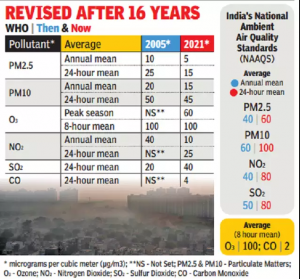
Governments Measures taken:
- Notification of National Ambient Air Quality Standards and sector-specific emission and effluent standards for industries;
- Setting up of monitoring network for assessment of ambient air quality;
- Introduction of cleaner gaseous fuels like CNG, LPG etc and ethanol blending;
- Launching of National Air Quality Index (AQI);
- Leapfrogging from BS-IV to BS-VI standards for vehicles by 1st April 2020;
- Regulating the bursting of pollution-emitting crackers;
- Notification of graded response action plan for Delhi identifying source-wise actions for various levels of air pollution, etc.
- National Clean Air Programme.
THE SCIENCE AND TECHNOLOGY
5. BIOLOGICAL E. TO RECEIVE MRNA VACCINE TECHNOLOGY FROM WHO
THE CONTEXT: Vaccine maker Biological E has been selected to receive mRNA technology from the World Health Organization technology transfer hub.
THE EXPLANATION:
- After examining a number of proposals from India, the WHO’s Advisory Committee on Vaccine Product Development has selected Biological E as a recipient.
- The WHO’s technology transfer hub has the potential to expand manufacturing capacity for other products as well, including treatments, and target other priorities such as malaria, HIV and cancer. The WHO and partners will work with the Indian government and Biological E to put in place training and support for the company to start producing mRNA vaccines.
BACKGROUND:
The COVID-19 pandemic awakened the world to the power of RNA therapies — two of the first vaccines that emerged in late 2020, Pfizer-BioNTech and Moderna, used this technology. At Present, an Indian company is developing an mRNA vaccine from scratch, signalling possibilities of the use of the molecule in a variety of diseases beyond COVID-19.
What are mRNA vaccines and how do they work?
- Most vaccines contain weakened or dead bacteria or viruses. However, scientists have developed a new type of vaccine that uses a molecule called messenger RNA (or mRNA for short) rather than part of an actual bacteria or virus. Messenger RNA is a type of RNA that is necessary for protein production.
- In cells, mRNA uses the information in genes to create a blueprint for making proteins. Once cells finish making a protein, they quickly break down the mRNA. mRNA from vaccines does not enter the nucleus and does not alter DNA.
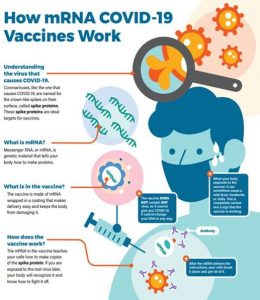
THE PRELIMS PRACTICE QUESTIONS
QUESTION OF THE DAY
Q1. Consider the following statements about the Jagannath Puri temple:
- It is built by kings of the Pala dynasty
- It is an example of Kalinga Architecture
Which of the statements given above is/are correct?
a) 1 only
b) 2 only
c) Both 1 and 2
d) Neither 1 nor 2
ANSWER FOR 4TH APRIL 2022
Answer: d)
Explanation:
UNEP hosts the secretariats of several multilateral environmental agreements and research bodies, including CBD, The Minamata Convention on Mercury, CMS and CITES.
Day-177 | Daily MCQs | UPSC Prelims | CURRENT DEVELOPMENT
[WpProQuiz 193]
ANTIMICROBIAL RESISTANCE
THE CONTEXT: According to a report published in The Lancet (Global burden of Bacterial AMR in 2019: A Systematic Analysis) about 4.95 million deaths in 2019 are associated with AMR and 1.27 million deaths were caused due to AMR. Anti-microbial Resistance is a leading cause of death around the world, with the highest number of deaths occurring in low-resource settings. Everyone is at risk from AMR, but young children are particularly affected. The following article explains the causes of AMR and the challenges involved, from a scientific and public health perspective.
ABOUT AMR
- Antimicrobial resistance is the resistance acquired by any microorganism (bacteria, viruses, fungi, parasites, etc.) against antimicrobial drugs (such as antibiotics, antifungal, and antiviral drugs) that are used to treat infections. As a result, standard treatments become ineffective, infections persist, and may spread to others.
- Resistant microbes are more difficult to treat which necessitates alternative mechanisms or higher doses, both of which are either more toxic or expensive.
- Microorganisms that develop antimicrobial resistance are sometimes referred to as “superbugs”.
- Antimicrobial resistance occurs naturally, but the misuse of antibiotics in humans and animals is accelerating the process. Antimicrobial resistance is now regarded as a major threat to public health across the globe.
Bacterial antimicrobial: resistance occurs when changes in bacteria cause the drugs used to treat the infection to become less effective.
CAUSES OF ANTIBIOTIC RESISTANCE
OVERUSE:
- Overuse of antibiotics by consuming more antibiotics than prescribed.
- Overuse of antibiotics in livestock and fish farming. Consumption of antibiotically treated livestock such as chicken further increases resistance.
- Using antibiotics in farm animals can promote AMR. Drug-resistant bacteria can be found in meat and food crops that have exposure to fertilizers or contaminated water. The chances of Zoonotic diseases passing on to humans can increase.
MISUSE:
- Misuse by taking a prescribed antibiotic incorrectly or taking antibiotics to treat viral infection. Patients generally do not complete the entire antibiotic course.
- Include self-medication.
- access to antibiotics without prescription.
- Lack of knowledge about when to use antibiotics.
PHARMA WASTE AND DISCHARGE:
- Antibiotics discharge or waste from pharma firms and hospitals. For instance, Hyderabad’s pharmaceutical industry has been pumping massive amounts of antibiotics into local lakes, rivers, and sewers. This has led to an explosion in resistance genes in these water bodies.
HEALTHCARE SETTINGS:
- Poor infection control in healthcare settings.
- Poor hygiene and sanitation.
- A report on hand-washing practices of nurses and doctors found that only 31.8% of them washed hands after contact with patients.
EXCESSIVE USE OF FDC DRUGS:
- Excessive use of Fixed Dose Combinations (FDC) Drugs due to their low price and convenience enables anti-biotic resistance to grow at a significant rate. This may also lead to the emergence of bacterial strains resistant to multiple antibiotics.
WRONG DIAGNOSIS:
- Health professionals sometimes prescribe antimicrobials “just in case,” or they prescribe broad-spectrum antimicrobials when a specific drug could have satisficed. Using medications in such a fashion increases the risk of AMR.
RISING CHALLENGES BECAUSE OF AMR
THREAT TO PREVENTION OF INFECTIONS: Medical procedures such as organ transplantation, cancer chemotherapy, diabetes management and major surgery (for example, cesarean sections or hip replacements) will become very risky.
GLOBAL THREAT: AMR poses a serious threat to global health, food security, and development.
SIDE EFFECTS: Increased side effects from the use of multiple and more powerful medications.
COSTS AND CASUALTIES:
- The danger of antimicrobial resistance is those treatable illnesses like pneumonia, tuberculosis, or minor infections could become incurable. This would put a greater economic and emotional burden on families and on our healthcare system.
- Increased cost and length of treatments and increased deaths.
RISK TO GAINS MADE IN THE PAST:
- Without effective antibiotics for the prevention and treatment of infections, the achievements of modern medicine are put at a risk.
- Antimicrobial resistance is putting the gains of the Millennium Development Goals at risk and endangers the achievement of the Sustainable Development Goals.
ANTIBIOTIC APOCALYPSE:
- Without urgent positive action, we might be heading to a future without antibiotics, with bacteria becoming completely resistant to treatment and when common infections and minor injuries could even prove fatal.
STEPS TAKEN BY THE WORLD HEALTH ORGANISATION (WHO)
GLOBAL ACTION PLAN:
Global action plan on antimicrobial resistance with 5 strategic objectives:
- To improve awareness and understanding of antimicrobial resistance.
- To strengthen surveillance and research.
- To reduce the incidence of infection.
- To optimize the use of antimicrobial medicines.
- To ensure sustainable investment in countering antimicrobial resistance.
REVISION OF ANTIBIOTICS PROTOCOL:
WHO has revised the antibiotics protocol to curb antibiotic resistance in 2017. This was the biggest revision of the antibiotics section in the essential medicines list (EML) which is being used by countries to develop their own local lists of essential medicine.
- Under this, WHO has divided the drugs into 3 categories viz – access, watch, and reserve.
- The access category includes commonly used antibiotics available at all times for the treatment of a broad range of common infections.
- The watch category covers antibiotics that are recommended as a first or second choice treatment for a small group of infections. Prescription of these drugs should be minimized to avoid further development of resistance.
- The reserved category includes antibiotics that are considered last-resort options and should be used only in the most severe circumstances like life-threatening infections caused by multi-drug resistant (MDR) bacteria.
ANTIMICROBIAL RESISTANCE IN INDIA
- AMR is of particular concern in developing nations, including India, where the burden of infectious disease is high and healthcare spending is low. India is among the nations with the highest burden of bacterial infections and hence the impact of AMR is likely to be higher in the Indian setting.
- India has been referred to as ‘the AMR capital of the world’. While on one hand, the emergence of newer multi-drug resistant (MDR) organisms pose newer diagnostic and therapeutic challenges, on the other hand, India is still striving to combat old enemies such as tuberculosis, malaria, and cholera pathogens, which are becoming more and more drug-resistant.
- Factors such as poverty, illiteracy, overcrowding, and malnutrition further compound the situation. Lack of awareness about infectious diseases in the general masses and inaccessibility to healthcare often preclude them from seeking medical advice.
- According to the World Health Organisation (WHO), antibiotic resistance may cause an increase in the death of Indians to 20 lakhs per year by 2050.
- The National Health Policy 2017 highlights the problem of antimicrobial resistance and calls for effective action to address it.
- MDR-TB and XDR-TB in India: The World Health Organisation estimates approximately 4.1 million people across the world suffer from tuberculosis, but these cases continue to remain undiagnosed and unreported. A total of 1.5 million people died from TB in 2020 making it the second leading infectious killer only after Covid-19.
- MDR-TB: Multidrug Resistant TB
- XDR-TB: Extremely Drug-Resistant TB
- While India is on a mission to become TB free by 2025, the report by Haystack Analytics indicates that the country continues to bear the largest share of TB cases in the world, with 65% of the cases being reported in the most economically productive population segment of 15-45. Not only this can have a detrimental impact on the economy, but the situation can also aggravate considerably, if not addressed in due time.
- XDR-TB has become a new threat to the control of TB in many countries including India. Its prevalence is not known in India as there is no nationwide surveillance. However, there have been some reports from various hospitals in the country
STEPS TAKEN BY INDIA IN FIGHT AGAINST AMR
RED LINE CAMPAIGN:
- It was launched in 2016.
- Under this, Prescription only antibiotics were marked with a red line to curb irrational use.
- The government has also backed it up with an awareness campaign that red-line medicines should not be taken without a prescription.
ANTI-MICROBIAL RESISTANCE FUND:
- India-focused seed fund.
- Investment by the Department of Biotechnology (DBT) through the Biotechnology Industry Research Assistance Council (BIRAC).
- It will help groups in India compete for the Longitude prize (for groups that develop effective and affordable diagnostic kits to detect antimicrobial resistance).
AMRRSN:
National Anti-Microbial Resistance Research and Surveillance Network (AMRRSN) was established by the Indian Council of Medical Research (ICMR).
- To strengthen surveillance of AMR in the country.
- To enable compilation of national data of AMR at various levels of health care.
NATIONAL ACTION PLAN TO COMBAT ANTIMICROBIAL RESISTANCE, 2017:
- Enhancing awareness among the masses and strict adulteration laws.
- Strengthening surveillance.
- Improving the rational use of antibiotics.
- Reducing infections.
- Promoting policies and research in antimicrobial resistance.
- Support neighboring nations in the fight against infectious diseases
AMR RESEARCH & INTERNATIONAL COLLABORATION:
- ICMR has taken measures to develop new drugs /medicines using international collaborations for strengthening medical research in AMR.
INITIATIVES TO CONTROL OVERUSE OR MISUSE OF ANTIBIOTICS:
- ICMR has launched an antibiotic stewardship program (AMSP) on a pilot project basis in twenty tertiary care hospitals across India to check the misuse and overuse of antibiotics in hospital wards and ICUs.
- On the advice of ICMR, DCGI has prohibited 40 fixed-dose combinations (FDCs) which were found inapplicable.
- ICMR collaborated with the Indian Council of Agriculture Research, Department of Animal Husbandry, Dairy and Fisheries, and the DCGI to prohibit the use of Colistin as a growth promoter in animal feed in poultry.
- The government has also capped the maximum levels of drugs that can be used for growth promotion in meat and meat products.
CHALLENGES FOR INDIA IN ITS FIGHT AGAINST AMR
TWIN CHALLENGE:
- India faces a twin challenge of fighting the over consumption of antibiotics while ensuring that the poor and vulnerable have easy access.
LACK OF AWARENESS:
- Lack of awareness among medical practitioners as well as the general public on the rational use of antibiotics further aggravates the problem.
COORDINATION GAP:
- Coordination among various ministries and between the center and state governments.
- A cross-cutting program dealing with antimicrobial resistance across multiple microbes has been lacking.
ABSENCE OF A ONE HEALTH APPROACH:
- One Health Approach to addressing AMR recognizes that human well-being is inextricably tied to the health of animals and the environment.
ABSENCE OF STRINGENT RULES:
- The absence of stringently framed and implemented regulatory frameworks to limit the use of antimicrobials in livestock and food animals, especially for non-therapeutic purposes, has been one of the drivers of antibiotic overuse at the community level.
- The rules and regulations that were taken were not strict enough to prevent pharmaceutical firms to sell last-resort drugs to farmers or discharging waste into water bodies.
- In India, current effluent standards do not include antibiotic residues, and thus they are not monitored in the pharmaceutical industry effluents.
THE WAY FORWARD
- Infection control in healthcare facilities:
- Health professionals prescribe antibiotics only when they are needed.
- Preventing infections by maintaining hygiene.
- Creating awareness about the use and abuse of antibiotics:
- Individuals to use antibiotics only when prescribed.
- Only give antibiotics to animals under veterinary supervision.
- Vaccinate animals to minimize the need for antibiotics.
- Use alternatives to antibiotics when available.
- A robust national action plan to tackle antibiotic resistance.
- Improve surveillance of antibiotic-resistant infections.
- Invest in R&Dfor new antibiotics to keep up with resistant bacteria as well as in new diagnostic tests to track the development of resistance.
THE CONCLUSION: There is a need to urgently address antimicrobial resistance in a holistic way by integrating human, animal and environmental health. All countries need to work together to limit the spread of Antibiotic-Resistant Genes (ARGs). Even though national action plans have been laid down by most countries, these plans have yet to move from paper to the ground as antibiotics continue to be freely used,therefore to contain AMR, there is a need for a One Health Approach through coherent, integrated, multi-sectoral cooperation and actions.
MAINS QUESTIONS:
- “Addressing AMR requires a multipronged and multisectoral approach. The urgency to develop new drugs should not discourage us from instituting measures to use the existing antimicrobials judiciously.” Comment.
- “The progress under the National Action Plan for AMR(2017) has been far from satisfactory.” Critically analyze.
- What do you understand by Antimicrobial Resistance (AMR)? Explain the reasons for the spread of AMR and the challenges involved to control it.
Ethics Through Current Developments (04-04-2022)
Today’s Important Articles for Geography (04-04-2022)
Today’s Important Articles for Pub Ad (04-04-2022)
Today’s Important Articles for Sociology (04-04-2022)
WSDP Bulletin (04-04-2022)
(Newspapers, PIB and other important sources)
Prelim and Main
- NFC technology for instant payments READ MORE
- The key takeaways of a UNEP report on noise pollution READ MORE
- Government panel recommends inclusion of Covovax in national COVID-19 vaccination drive for 12-17 age group READ MORE
- India, Australia sign FTA, trade likely to ‘double in 5 yrs, generate 1 mn jobs’ READ MORE
- Technological advancements in India’s Aerospace and Defence sector READ MORE
- Prehistoric relics point to riverine settlement at Attappady READ MORE
- WHO records new recombinant SARS-CoV-2 variant READ MORE
Main Exam
GS Paper- 1
- Manual scavenging is a blot on society READ MORE
- Who Has an Authentic Conception of ‘Generation’? READ MORE
GS Paper- 2
POLITY AND GOVERNANCE
- Explained: Reforming death penalty READ MORE
- Rethink the criminal identification bill READ MORE
- To fix India’s criminal justice system, weed out the corrupt first READ MORE
INTERNATIONAL ISSUES
- Playing the strategic autonomy game: New Delhi should play its cards extremely well right now to invest in future geopolitical dividends READ MORE
- BIMSTEC can boost ties with the East READ MORE
- India puts itself first READ MORE
GS Paper- 3
ECONOMIC DEVELOPMENT
- Renewable energy has a tariff problem. Here’s how to fix it READ MORE
- RBI’s shift in stance imminent READ MORE
- Ways to take Russia-India trade forward READ MORE
- Balance economic & environment policies READ MORE
- The need for evaluation of fiscal policies READ MORE
ENVIRONMENT AND ECOLOGY
- Climate and Us | The Parvati Valley forest fire is a sign of the times to come READ MORE
- A Promising Conservation Policy for India: Climate Change and the Miyawaki Forests READ MORE
SECURITY
- For a full repeal: The relaxation of AFSPA is welcome, but the demand for full repeal should be considered READ MORE
GS Paper- 4
ETHICS EXAMPLES AND CASE STUDY
- Hellenic wisdom: Balm for frayed nerves READ MORE
- Clash and Creation READ MORE
- In Pursuit of Happiness: The efforts to officially prepare indexed happiness are nothing but an ideological production. READ MORE
Questions for the MAIN exam
- ‘Contemporary Indian diplomacy is a textbook example of a swing state that refuses to swing either way.’ Comment in the light of India’s stand on Ukraine-Russia war.
- “You must change your approach in order to change your results”. Explain the importance of given quotation in a Civil servant life?
- How far do you agree with this view that to achieve $5 Trillion economy, India needs a regional free trade agreement with neighbouring countries and BIMSTEC group is the ideal group for it? Analyse your view.
QUOTATIONS AND CAPTIONS
- New Delhi should play its cards extremely well right now to invest in future geopolitical dividends.
- You must change your approach in order to change your results.
- Shifting to a two-part tariff for solar and wind will incentivise private investments.
- Geopolitical choices are almost never black and white, nor are they always readily available. Sometimes, therefore, states must proactively try to shape the environment to generate new options. It is New Delhi’s turn to do so.
- The Russia-Ukraine conflict has only worsened the growth-inflation matrix and raised the spectre of tighter financial conditions.
- India cannot forsake defence ties with Russia. To sidestep Western sanctions, the two nations can revisit rupee-rouble system.
- India as well as other neighbouring countries on the east can gain mutually. This way, India’s act East policy may strengthened.
- Improved connectivity will usher in lower trade cost which could be the driving force for gains from BIMSTEC.
- Criminal identification bill places the privacy of individuals at the mercy of the State; allows for the retention of personal data of convicted individuals for lifetime; and goes against the best practices of data protection.
- The West’s real agenda is the reimposition of a unipolar world order to perpetuate its domination of the international economic and political order.
- The political leadership addressing BIMSTEC cooperation have to realise that pushing a free trade agreement is going to be a domestic exercise, where their own political opponents would create roadblocks.
- In India, it is very difficult to stop a bad economic idea whose time has come, but there is a need for a rigorous assessment of the quality of expenditures by various state governments.
50-WORD TALK
- A longer-term option for countries that are adversely affected by the Western sanctions would be the development of financial messaging systems that can be alternatives to the SWIFT. Russia has developed its own financial messaging system, the SPFS (roughly translated as System for Transfer of Financial Messages) and China has its own Cross-Border Interbank Payment System, or CIPS.
- Air pollution is rising due to the failure of the State and the market forces to give importance to environment. Its genesis lies in policy failure and implementation of less stringent laws & regulations to attract more investment from the developed world. The free market considers only the private cost of production. It fails to consider the social cost of pollution.
Things to Remember:
- For prelims-related news try to understand the context of the news and relate with its concepts so that it will be easier for you to answer (or eliminate) from given options.
- Whenever any international place will be in news, you should do map work (marking those areas in maps and exploring other geographical locations nearby including mountains, rivers, etc. same applies to the national places.)
- For economy-related news (banking, agriculture, etc.) you should focus on terms and how these are related to various economic aspects, for example, if inflation has been mentioned, try to relate with prevailing price rises, shortage of essential supplies, banking rates, etc.
- For main exam-related topics, you should focus on the various dimensions of the given topic, the most important topics which occur frequently and are important from the mains point of view will be covered in ED.
- Try to use the given content in your answer. Regular use of this content will bring more enrichment to your writing.
DAILY CURRENT AFFAIRS (APRIL 03 & 04, 2022)
THE POLITY AND GOVERNANCE
1. NEW CRIMINAL PROCEDURE (IDENTIFICATION) BILL, 2022
THE CONTEXT: According to the new provisions of the Criminal Procedure (Identification) Bill, it will allow police and prison authorities to collect, store and analyze physical and biological samples including the retina and iris scans of convicted, arrested, and detained persons.
THE EXPLANATION
What is the legislation about?
- The Bill seeks to repeal the Identification of Prisoners Act, 1920. The over 100-year-old Act’s scope was limited to capturing finger impressions, footprint impressions, and photographs of convicted prisoners and a certain category of arrested and non-convicted persons on the order of a Magistrate.
- The Statement of Objects and Reasons of the 2022 Bill said that new ‘‘measurement’’ techniques being used in advanced countries are giving credible and reliable results and are recognized the world over. It said that the 1920 Act does not provide for taking these body measurements as many of the techniques and technologies had not been developed then.
What are the major changes proposed?
It proposes four major changes.
- First, it would define ‘‘measurements’’ to include “signature, handwriting, iris and retina scan, physical, biological samples, and their analysis, etc.” It does not specify what analysis means, implying that it may also include storing DNA samples. The “etc.” mentioned in the text of the Bill could give unfettered powers to law enforcement agencies to interpret the law at their convenience, sometimes to the disadvantage of the accused.
- Second, it empowers the National Crime Records Bureau of India (NCRB), under the Union Home Ministry, to collect, store and preserve the record of measurements for at least 75 years. The NCRB will be able to share the data with other law enforcement agencies as well. Police is a State subject and NCRB works under the Union government, and experts contend this provision may impinge on federalism.
- Third, it empowers a Magistrate to direct any person to give vital details, which till now was reserved for convicts and those involved in heinous crimes.
- Fourth, it empowers police or prison officers up to the rank of a Head Constable to take details of any person who resists or refuses to do so.
What are some other changes?
- The Bill also seeks to apply to persons detained under any preventive detention law. The Bill also authorizes taking vital details of “other persons” for identification and investigation in criminal matters. It doesn’t define the “other persons”, implying its ambit extends beyond convicts, arrested persons, or detainees.
- The Bill’s stated objective is it provides legal sanction for taking such details and will make the investigation of crime more efficient and expeditious, and help in increasing the conviction rate.
THE INTERNATIONAL RELATIONS
2. INDIA-AUSTRALIA ECONOMIC COOPERATION AND TRADE AGREEMENT (ECTA)
THE CONTEXT: India and Australia signed an Economic Cooperation and Trade Agreement (IndAus ECTA) which is set to provide zero-duty access to 96 percent of India’s exports to Australia including shipments from key sectors such as engineering goods, gems, jewelry, textiles, apparel, and leather.
THE EXPLANATION:
- ECTA encompasses cooperation across the entire gamut of bilateral economic and commercial relations between the two friendly countries and covers areas like Trade in Goods, Rules of Origin, Trade in Services, Technical Barriers to Trade (TBT), Sanitary and Phytosanitary (SPS) measures, Dispute Settlement, Movement of Natural Persons, Telecom, Customs Procedures, Pharmaceutical products, and Cooperation in other Areas.
- Goods: The ECTA between India and Australia covers almost all the tariff lines dealt in by India and Australia respectively. India will benefit from preferential market access provided by Australia on 100% of its tariff lines.
- This includes all the labor-intensive sectors of export interest to India such as Gems and Jewellery, Textiles, leather, footwear, furniture, food, agricultural products, engineering products, medical devices, and Automobiles.
- On the other hand, India will be offering preferential access to Australia on over 70% of its tariff lines, including lines of export interest to Australia which are primarily raw materials and intermediaries such as coal, mineral ores and wines, etc.
- Services: As regards trade in services, Australia has offered wide-ranging commitments in around 135 sub-sectors and Most Favoured Nation (MFN) in 120 sub-sectors which cover key areas of India’s interest like IT, ITES, Business services, Health, Education, and Audiovisual.
- Some of the keys offered by Australia in the services space include a Quota for chefs and yoga teachers; a Post-study work visa of 2-4 years for Indian students on a reciprocal basis; mutual recognition of Professional Services and Other licensed/regulated Occupations; and Work & Holiday visa arrangement for young professionals.
- On the other hand, India has offered market access to Australia in around 103 sub-sectors and Most Favoured Nation in 31 sub-sectors from the 11 broad service sectors such as ‘business services’, ‘communication services’, ‘construction and related engineering services, and so on. Both sides have also agreed to a separate Annex on Pharmaceutical products under this agreement, which will enable fast-track approval for patented, generic, and biosimilar medicines.
- India and Australia are partners in the trilateral Supply Chain Resilience Initiative (SCRI) arrangement along with Japan which seeks to enhance the resilience of supply chains in the Indo-Pacific Region. Further, India and Australia are also members of the recently formed Quad, also comprising the US, and Japan, to further enhance cooperation and develop partnerships across several issues of common concerns.
- The India-Australia ECTA will further cement the already deep, close, and strategic relations between the two countries and will significantly enhance bilateral trade in goods and services, create new employment opportunities, raise living standards, and improve the general welfare of the peoples of the two countries.
Background:
- India-Australia bilateral trade for both merchandise and services is valued at US$ 27.5 billion in 2021. India’s merchandise exports to Australia consist primarily of a broad-based basket largely of finished products like gold jewelry, polished diamonds, etc. India’s merchandise imports consist largely of raw materials, minerals, and intermediate goods.
THE SCIENCE AND TECHNOLOGY
3. NFC TECHNOLOGY FOR INSTANT PAYMENTS
THE CONTEXT: Google Pay has recently launched a new feature in India, ‘Tap to pay for UPI’, in collaboration with Pine Labs. The feature makes use of Near Field Communication (NFC) technology.
THE EXPLANATION:
What is NFC and how does it work?
- NFC is a short-range wireless connectivity technology that allows NFC-enabled devices to communicate with each other and transfer information quickly and easily with a single touch — whether to pay bills, exchange business cards, download coupons, or share a document.
- NFC transmits data through electromagnetic radio fields, to enable communication between two devices. Both devices must contain NFC chips, as transactions take place within a very short distance. NFC-enabled devices must be either physically touching or within a few centimeters from each other for data transfer to occur.
How will this technology work with the recently launched feature, ‘Tap to pay for UPI’?
- Google Pay has been the first among UPI apps to bring the Tap to Pay feature working on POS terminals. It will allow users with UPI accounts configured on Google Pay to make payments just by tapping their NFC-enabled Android smartphones on any Pine Labs Android POS terminal.
- Once users tap their phones on the POS terminal, it will automatically open the Google pay app with the payment amount pre-filled. Users can then verify the amount and merchant name and authenticate the payment, using their UPI PIN. They will be notified once the payment is successful.
- The process is much faster compared to scanning a QR code or entering the UPI-linked mobile number which has been the conventional way till now.
What are the other applications of NFC technology?

How safe is this technology?
- NFC technology is designed for an operation between devices within a few centimeters from each other. This makes it difficult for attackers to record the communication between the devices compared to other wireless technologies which have a working distance of several meters.
- The user of the NFC-enabled device determines by the touch gesture which entity the NFC communication should take place with, making it more difficult for the attacker to get connected. The security level of NFC communication is by default higher compared to other wireless communication protocols.
- The NFC Forum has also added Peer to Peer communication which is a mechanism to cipher all exchanged data to avoid external interpretation of recorded communication. Since the receiving device reads your data the instant you send it, NFCs also reduce the chance of human error.
THE GOVERNMENT SCHEMES AND INITIATIVES IN THE NEWS
4. IDEX INITIATIVE
THE CONTEXT: Innovations for Defence Excellence (iDEX) framework was launched by the Government to foster innovation and technology development in Defence and Aerospace Sector by engaging Industries including MSMEs, startups, individuals innovators, R&D institutes, and academia and promoting self-reliance.
THE EXPLANATION:
- The Government has approved a central sector scheme for iDEX with budgetary support of Rs. 498.78 crore for the next 5 years from 2021-22 to 2025-26.
- Aim: to foster innovation and technology development in Defence and Aerospace Sector by engaging Industries including MSMEs, startups, individual innovators, R&D institutes, and academia and promote self-reliance.
About Innovations for Defence Excellence (IDX):
- The Government has approved a central sector scheme for iDEX with budgetary support of Rs. 498.78 crore for the next 5 years from 2021-22 to 2025-26.
- Objective of the scheme: to provide financial support to nearly 300 Startups/ MSMEs/individual innovators and about 20 Partner incubators through the Defence Innovation Organisation (DIO).
- For the current financial year 2021-2022, Rs. 45 crore have been released by the Government to iDEX-DIO.
- The iDEX framework and establishment of the DIO by the Department of Defence Production (DDP) is aimed at promoting innovation and indigenization in the aerospace and defense sector at the start-up level.
- iDEX will be funded and managed by a “Defence Innovation Organisation (DIO)‟ formed as a “not for profit‟ company as per Section 8 of the Companies Act 2013 for this purpose.
- It aims at empowering a culture of technology co-creation and co-innovation in the sector and boosts innovation among the start-ups and encourages them to be a part of the ecosystem.
THE HEALTH AND COVID CORNER
5. WHO RECORDS THE NEW SARS-COV-2 VARIANT
THE CONTEXT: The World Health Organization (WHO) has flagged the emergence of a new variant of the SARS-CoV-2 virus, the XE recombinant, in the United Kingdom, and with a possibly higher rate of transmission.
THE EXPLANATION:
- The WHO, in its recent epidemiological update, said the recombinant was detected in the United Kingdom on January 19, 2022, and over 600 sequences have been reported and confirmed since.
- It also added, “the early-day estimates indicate a community growth rate advantage of about 10% as compared to BA.2, however, this finding requires further confirmation.”
- The U.K. Health Security Agency (UKHSA), which tracks SARS-CoV-2 variants, analyzed three recombinants, known as XF, XE, and XD. Of these, XD and XF is recombinant of Delta and Omicron BA.1, while XE is a recombinant of Omicron BA.1 and BA.2.
- According to WHO, While XE only accounts for a small fraction of the cases, its extremely high transmissibility could mean that it becomes the most dominant strain shortly.
- A recombinant variant occurs when an individual becomes infected with two or more variants at the same time, leading to a mixing of genetic material in the human body. Several such recombinants have emerged in the past during the pandemic.
- The UKHSA has stated that in the United Kingdom, only 38 cases of XF recombinant have been identified, though none since mid-February 2022.
- The new variant is 10 percent more transmissible than the most contagious BA.2 subvariant.
THE DATASHEET
6. THE SPACE JUNK, A CAUSE OF CONCERN
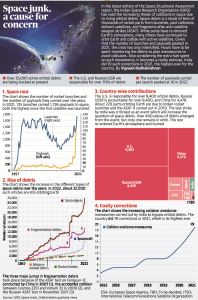
THE PRELIMS PRACTICE QUESTIONS
QUESTION OF THE DAY
Q1. UNEP hosts a secretariat of which of the following?
- Convention on Migratory Species
- Minamata Convention
- Convention on Biodiversity
Select the correct answer using the code given below:
(a) 1 and 2 only
(b) 1 and 3 only
(c) 2 and 3 only
(d) All of them
ANSWER FOR 2ND APRIL 2022
Answer: B
Explanation:
- Olive Ridley Turtles (Lepidochelys olivacea) are migratory species visiting Indian coasts for nesting.
- These turtles travel all the way from the South Pacific Ocean to breed on the coast of Gahirmatha.
- Their mass nesting phenomenon is called arribadas.
- IUCN Status: Vulnerable
- They have the highest degree of protection as they are included in Schedule-I of the Wildlife (Protection) Act, 1972.
- The turtle eggs normally take 45 days to hatch. After this, tiny hatchlings come out and make their way to the sea.
- Threats: Heavy predation of eggs by dogs and wild animals, indiscriminate fishing with trawlers and gill nets, and beach soil erosion.
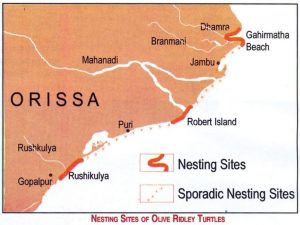
Day-176 | Daily MCQs | UPSC Prelims | MODERN HISTORY OF INDIA
[WpProQuiz 192]
HOW DID THE LI-ION BATTERY SET OFF A TECHNOLOGY REVOLUTION?
THE CONTEXT: Recently, the Union Minister of Road Transport and Highways said rapid strides in technology and green fuel will reduce the cost of electric automobiles, bringing them at par with petrol-run vehicles in two years. Also, the 2019 Nobel Prize for Chemistry was awarded to John B. Goodenough, M. Stanley Whittingham, and Akira Yoshino for working towards the development of practical lithium-ion batteries.
In this context, this article analyses the scope of the Lithium-Ion Battery Market: Industry Trends, Share, Size, Growth, Opportunity, and the way forward.
THE EXPLANATION
What is a lithium-ion battery and how does it work?
- A lithium-ion battery is a type of rechargeable battery that is charged and discharged by lithium ions moving between the negative (anode) and positive (cathode) electrodes. (Generally, batteries that can be charged and discharged repeatedly are called secondary batteries, whereas disposable batteries are called primary batteries.)
- Because lithium-ion batteries are suitable for storing high-capacity power, they are used in a wide range of applications, including consumer electronics such as smartphones and PCs, industrial robots, production equipment, and automobiles.

Lithium-ion Battery – Applications
⦁ Electronic gadgets
⦁ Tele-communication
⦁ Aerospace
⦁ Industrial applications
⦁ Lithium-ion battery technology has made it the favorite power source for electric and hybrid electric vehicles
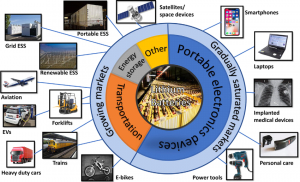
SIGNIFICANCE OF LI-ION BATTERIES IN THE CONTEXT OF THE ELECTRONIC MARKET
According to the Ministry of Commerce and Industry, India imported lithium cells and batteries – including rechargeable li-ion type devices – worth INR 8,984 crore in the last fiscal year (2020-2021). This figure consisted of INR 173 crore of non-rechargeable lithium devices and INR 8,811 crore of lithium-ion products.
China and Hong Kong were the chief sources of imports with China shipping 72.73% of the lithium-ion products imported by India and 32.05% of the non-rechargeable lithium cell devices. Hong Kong products accounted for 23.48% and 37.32% of those respective markets.
Indian lithium battery demand is expected to surge with the products used in renewable energy storage facilities and electric vehicles as well as data centers and consumer electronics. According to other data, the Indian lithium-ion battery market reached a value of US$ 2.1 Billion in 2021.
THE DOMESTIC PUSH
Recently, the Geological Survey of India has taken up seven other lithium exploration projects in Karnataka, Arunachal Pradesh, Andhra Pradesh, Chhattisgarh, Jharkhand, Jammu and Kashmir, and Rajasthan.
The reason: The ancient igneous rock deposits in the region (a by-product of large-scale volcanic activity in the Deccan plateau millions of years ago) hold the first traces of Lithium ever to be discovered in India
MAJOR IMPACTS ON E-VEHICLES: A POTENTIAL ALTERNATIVE TO REDUCE THE COAL DEPENDENCY
One of the major factors driving the rising demand for Lithium-Ion batteries is the growing popularity of electric cars. Rising EV sales across the country, particularly in the 2- and 3-wheeler segments, have boosted the demand. Lithium batteries have transformed how they are utilized due to their advantages over lead-acid batteries.
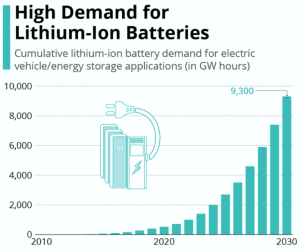
By 2030, the market for electric vehicle
power packs are expected to reach $300 billion, with a large secondary market of more than 2.5 million e-rickshaws and 4,00,000 lead-acid battery-powered two-wheelers now on the road.
The most expensive component of an electric car is the lithium-ion battery, which accounts for 40-50 percent of the total cost. With the growing use of electric vehicles in our transportation system, the demand for Li-ion batteries for EV applications is expected to soar. Other uses, such as renewable energy integration with the grid, will raise Li-Ion battery demand in addition to electric vehicles.
According to government projections, India would require a minimum of 10 GWh of Li-ion cells by 2022. By 2025, it will be around 60 GWh, and by 2030, it will be around 120 GWh.
Environmental Aspect:
- According to the World Air Quality Report 2021, published by Swiss Organization -IQ Air where it stated “India was home to 11 of the 15 most polluted cities in Central and South Asia in 2021. Delhi saw a 14.6% increase in PM2.5 concentrations in 2021, with levels rising to 96.4 µg/m3 from 84 µg/m3 in 2020.
- It also highlighted that sources of PM2.5 “include internal combustion engines, power generation, industrial processes, agricultural processes, construction, and residential wood and coal burning.
- According to a Government source, by 2030, nearly three-fourths of Indian two-wheelers and all new cars are expected to be EVs (electric vehicles). It will significantly reduce the dependency on coal and reduce pollution significantly.
MERITS OF LI-ION BATTERIES
Compared to their lead-acid counterparts, lithium-ion batteries are much lighter, more efficient, and have more power storage. These batteries are widely used commercially in mobiles, laptops, and other electronic equipment.
High energy density: High energy density is one of the chief advantages of lithium-ion battery technology. With electronic equipment such as mobile phones needing to operate longer between charges while still consuming more power, there is always a need for batteries with a much higher energy density.
For example, NiMH batteries would not be able to provide the charge capacity required for a modern smartphone. Using Nickel Metal Hydride battery technology, a smartphone would not last long enough, especially if the battery needed to keep within the same size constraints.
In addition to this, there are many power applications from power tools to electric vehicles. The much higher power density offered by lithium-ion batteries is a distinct advantage. Electric vehicles also need battery technology that has a high energy density.
Self-discharge: One issue with many rechargeable batteries is the self-discharge rate. The rate of self-discharge of Li-ion cells is much lower than that of other rechargeable cells such as Ni-Cad and NiMH forms. It is typically around 5% in the first 4 hours after being charged but then falls to a figure of around 1 or 2% per month.
Low maintenance: One major lithium-ion battery advantage is that they do not require maintenance to ensure their performance.
Ni-Cad cells required a periodic discharge to ensure that they did not exhibit the memory effect. As this does not affect lithium-ion batteries and cells, this process or other similar maintenance procedures are not required. Likewise, lead-acid cells require maintenance, some needing the battery acid to be topped up periodically.
Cell voltage: The voltage produced by each lithium-ion cell is about 3.6 volts. This has many advantages. Being higher than that of the standard nickel-cadmium, nickel-metal hydride, and even standard alkaline cells at around 1.5 volts and lead-acid at around 2 volts per cell, the voltage of each lithium-ion cell is higher, requiring fewer cells in many battery applications. For smartphones, a single cell is all that is needed and this simplifies the power management.
Variety of types available: There are several types of lithium-ion cells available. This advantage of lithium-ion batteries can mean that the right technology can be used for the application needed. Some forms of lithium-ion battery provide a high current density and are ideal for consumer mobile electronic equipment. Others can provide much higher current levels and are ideal for power tools and electric vehicles.
DEMERITS OF LI-ION BATTERIES
Fire Risk: Lithium-ion batteries, whether they are used in cars or electronic devices, can catch fire if they have been improperly manufactured or damaged, or if the software that operates the battery is not designed correctly.
The major weakness of lithium-ion batteries in electric cars is the use of organic liquid electrolytes, which are volatile and flammable when operating at high temperatures. An external force such as a crash can also lead to chemical leakage.
Protection/battery management system required: Lithium-ion cells and batteries are not as robust as some other rechargeable technologies. They require protection from being overcharged and discharged too far. In addition to this, they need to have the current maintained within safe limits. Accordingly, one lithium-ion battery disadvantage is that they require protection circuitry incorporated to ensure they are kept within their safe operating limits.
Aging: One of the major lithium-ion battery disadvantages for consumer electronics is that lithium-ion batteries suffer from aging. Not only is this time or calendar dependent, but it is also dependent upon the number of charge-discharge cycles that the battery has undergone.
Often batteries will only be able to withstand 500 – 1000 charge-discharge cycles before their capacity falls. With the development of Li-ion technology, this figure is increasing, but after a while, the battery may need replacing and this can be an issue if they are embedded in the equipment.
Cost: A major lithium-ion battery disadvantage is its cost. Typically, they are around 40% more costly to manufacture than Nickel-cadmium cells. This is a major factor when considering their use in mass-produced consumer items where any additional costs are a major issue.
Developing technology: Although lithium-ion batteries have been available for many years, they can still be considered an immature technology by some as it is very much a developing area. This can be a disadvantage in terms of the fact that the technology does not remain constant. However as new lithium-ion technologies are being developed all the time, it can also be an advantage as better solutions are coming available.
GOVERNMENT INITIATIVES TO PROMOTE ELECTRIC VEHICLES
- India is the fourth-largest auto market globally, and some estimates suggest there are close to 170 active investors in the country’s EV start-up ecosystem.
- To promote the adoption of EVs, the Department of Heavy Industry formulated a FAME India Scheme (Faster Adoption and Manufacturing of (Hybrid and) Electric Vehicles in India) in 2015.
The government has launched the following initiatives to Promote Electric Vehicles in India:
- Under the new GST system, GST on EVs is reduced from 12% to 5% against the 28% GST rate with up to 22% for conventional vehicles.
- The government has proposed the exemption of registration fees for battery-operated/electric vehicles to promote eco-friendly vehicles in the country.
- The Ministry of Power has also allowed the sale of electricity as a ‘service’ for electric vehicles’ charging. It will attract investors into the charging infrastructure.
- Also, The government has granted an exemption to battery-operated transport vehicles and vehicles that run on methanol and ethanol fuels from the requirements of the permit.
- The Ministry of Road Transport and Highways has allowed 16-18 years to obtain driving licenses to drive e-scooters.
- Lithium wars: Battery makers are also seeking to take advantage of the ₹18,100-crore production-linked incentive (PLI) scheme to manufacture lithium-ion cells within the country. In such a scenario, securing lithium supplies will play a critical role in the pivot towards a greener economy.
THE CONCLUSION: The use of Lithium-ion batteries is the future of a greener and eco-friendly environment. The use of lithium-ion batteries helps in cutting down the pollution level and improving the air quality. Energy storage and mobility are going to be the most popular concept in India as they won’t only save us costs but also have a huge positive impact on climate change. With the introduction of different government initiatives, the Indian Government is also trying to promote the use of batteries for a secure future. Having a manufacturing unit in India will help in cost reduction and increase employment.
Along with the batteries being manufactured, they can be recycled and reused too, decreasing the usage of gas and leading to an increase in pollution levels. For a better future, we need to start working today and have a clear vision toward the goal.
THE MAIN PRACTICE QUESTIONS:
- The Noble Prize in Chemistry of 2019 was jointly awarded to John B. Goodenough, M. Stanley Whittingham, and Akira Yoshino for working towards the development of practical lithium-ion batteries. How has this invention impacted the everyday life of human beings?
- What are the present challenges before the transition of shifting to e-vehicles? How do emerging technologies provide an opportunity for reducing coal dependency?
DAILY CURRENT AFFAIRS (APRIL 02, 2022)
THE POLITY AND GOVERNANCE
1. INDIAN ANTARCTIC BILL, 2022
THE CONTEXT: The Indian Antarctic Bill, 2022, introduced in Lok Sabha is pursuant to India’s accession to Antarctic Treaty, 1959 as well as the Protocol on Environment Protection (Madrid Protocol) to the Antarctic Treaty.
THE EXPLANATION:
Indian Antarctic Bill will also be useful in building credibility and enhancing the status of the country globally.
Objective:
- The Indian Antarctic Bill, 2022 introduced in Lok Sabha aims at providing national measures to protect the Antarctic environment, and the dependent and associated ecosystems.
- The Indian Antarctic Bill also aims to give effect to the Antarctic treaty, 1959, the protocol on the Environmental Protection to the Antarctic Treaty, 1998, and the Convention on the Conservation of Antarctic Marine Living Resources, 1982
- The latest bill also aims at promoting Antarctica as a natural reserve that is devoted to science and peace and to ensure that the Antarctic does not become the scene of international discord.
About India’s expedition to Antarctic
- The Indian Antarctic Programme is a multi-institutional, multi-disciplinary programme. It is under the control of the National Centre for Polar and Ocean Research, Ministry of Earth Sciences, Government of India.
- The Indian Antarctic Programme was initiated in 1981 with the first Indian expedition to Antarctica.
- It further gained global acceptance with India’s signing of the Antarctic Treaty as well as the construction of the Dakshin Gangotri Antarctic research base in 1983 which was superseded by the Maitri base from 1989.
- In 2012, the newest Bharati base was commissioned which was constructed out of 134 shipping containers.
- Under India’s Antarctic Programme, biological, earth, atmospheric, medical sciences, and chemical are studied in India. The country has carried out 30 scientific expeditions to the Antarctic as of October 14, 2010.
Value addition:
The Antarctic Treaty
- The Antarctic Treaty was signed in Washington on 1 December 1959 by the twelve nations (Argentina, Australia, Belgium, Chile, France, Japan, New Zealand, Norway, South Africa, United Kingdom, United States and USSR).
- The Treaty now has 52 signatories. India became a member of this treaty in 1983.
- Headquarters: Buenos Aires, Argentina.
- The Treaty, applies to the area south of 60° South latitude.
Provisions:
- Antarctica shall be used for peaceful purposes only(Art. I).
- Freedom of scientific investigation in Antarctica and cooperation toward that end shall continue(Art. II).
- Scientific observations and results from Antarctica shall be exchanged and made freely available(Art. III).
- Article IV effectively seeks to neutralise territorial sovereignty in Antarctica.
- The treaty also put a freeze on any disputes between claimants over their territories on the continent.
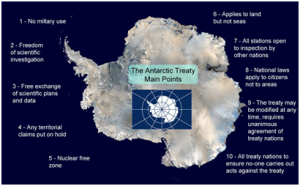
| Antarctic Treaty System:
· As disputes have arisen over the years, many have been addressed through the expansion of the treaty framework with these agreements. This framework is now referred to as the “Antarctic Treaty System”. The Antarctic Treaty system is made up of four major international agreements: · The 1959 Antarctic Treaty. · The 1972 Convention for the Conservation of Antarctic Seals. · The 1980 Convention on the Conservation of Antarctic Marine Living Resources. · The 1991 Protocol on Environmental Protection to the Antarctic Treaty. |
THE INTERNATIONAL RELATIONS
2. EXPLAINED: WHY INDIA’S PACT WITH SRI LANKA ON A MARITIME RESCUE CENTRE IS SIGNIFICANT
THE CONTEXT: The agreement appears to be part of India’s SAGAR (Security and Growth for all in the Region) initiative in the Indian Ocean, which has also seen India, Sri Lanka, and the Maldives give a new push to their 2011 Colombo Security Conclave that now includes Mauritius.
THE EXPLANATION:
- India and Sri Lanka have signed a Memorandum of Understanding for the Indian public sector Bharat Electronics Ltd (BEL) to set up a state-of-the-art Maritime Rescue Co-ordination Centre (MRCC) in Colombo.
- The agreement is significant as it enhances co-operation on maritime security between the two countries in a part of the Indian Ocean region where the India-China rivalry has taken centre stage over the last decade. Earlier this month, India also provided a naval floating dock to the Sri Lankan Navy, and two Dornier aircraft to the Sri Lankan Air Force.
- According to senior officials, the engagement between the forces of the two countries will augment interoperability and seamless maritime actions like carrying out anti-smuggling operations in the Indian Ocean Region.
Enhancing Sri Lanka capacity
- MRCCs are part of an international network under the UN’s International Maritime Organisation to monitor the sea lanes with the objective of swift response to emergencies, such as vessels in distress, rescue and evacuation of people, and prevention of and containing environmental disasters such as oil spills.
- Each country is responsible for its own Search and Rescue Region. The work of MRCCs is co-ordinated by the Navy or Coast Guard in each country. In India, the Coast Guard is the co-ordinating agency. In Sri Lanka, it is the Navy.
- The Bengaluru-based BEL has proposed enhancing Sri Lanka’s small MRCC by setting up advanced software systems that will increase Sri Lanka’s capacities for communication and co-ordination in its SRR (Search and Rescue Region) in the Indian Ocean, where it is the first responder. The MRCC will be established with a grant of $6 million from India.
- The enhanced MRCC will work out of the Sri Lankan Navy headquarters at Colombo, with a sub-center at Hambantota, where a Chinese state-owned company runs a deep water port that it helped to the bill, and which was controversially leased to it by Sri Lanka in 2016.
- Seven other sub-units along Sri Lanka’s coastline will make up the proposed new network. In situations in which regional assistance has to be mobilised, as happened with the two recent ship fires in Sri Lankan waters, this MRCC will be able to share information with its Indian counterparts.
SAGAR push
- Sri Lanka’s SRR is a wide swathe of 1,778,062. 24 sq km of the Indian Ocean and nearly 200 ships pass through these waters every day.
- The agreement appears to be part of India’s SAGAR (Security and Growth for all in the Region) initiative in the Indian Ocean, which has also seen India, Sri Lanka and Maldives give a new push to their 2011 Colombo Security Conclave that now includes Mauritius.
- The recent meeting of the CSC National Security Advisers identified “five pillars” of co-operation: maritime safety and security; countering terrorism and radicalisation; combating trafficking and transnational organised crime; cyber security, protection of critical infrastructure and technology; and humanitarian assistance and disaster relief.
THE ENVIRONMENT, ECOLOGY, AND CLIMATE CHANGE
3. RECORD NESTING OF OLIVE RIDLEY TURTLES
THE CONTEXT: As a record number of 4.92 lakh Olive Ridley turtles have crawled to the Rushikulya coast in Odisha, scientists have tagged more than 6,000 turtles to gather more information about their breeding behaviour and migration.
THE EXPLANATION:
- Odisha is the largest mass nesting site for Oliver Ridleys in the world. As temperatures start rising and getting warmer, the mass nesting season for Olive Ridley turtles on the Odisha coast starts. Lakhs of Olive Ridley sea turtles have flocked this year to Rushikulya river mouth for their annual mass nesting.
- These species flock to the place every year from the third week of February to the first week of March for nesting. After a long journey, all the way from the Indian Ocean, the turtles take a rest for some days after burying the eggs.
- According to the officials,This increased to 4.92 lakhs at Rushikulya and 5.20 lakhs at Gahirmatha.
- Arribada is a Spanish word meaning “arrival by sea” and refers to the mass nesting behaviour exhibited by Kemp’s Ridley and Olive Ridley sea turtles.
Value Addition:
Olive Ridley Sea Turtles
Olive Ridley Turtles (Lepidochelys olivacea) are migratory species visiting Indian coasts for nesting.
- These turtles travel all the way from the South Pacific Ocean to breed on the coast of Gahirmatha. Their mass nesting phenomenon is called arribadas.

- IUCN Status: Vulnerable; CITES: APPENDIX 1
- They have the highest degree of protection as they are included in Schedule-I of the Wildlife (Protection) Act, 1972.
- The turtle eggs normally take 45 days to hatch. After this, tiny hatchlings come out and make their way to the sea.
- Threats: Heavy predation of eggs by dogs and wild animals, indiscriminate fishing with trawlers and gill nets, and beach soil erosion.
- Every year, the Indian Coast Guard’s “Operation Olivia”, initiated in the early 1980s, helps protect Olive Ridley turtles as they congregate along the Odisha coast for breeding and nesting from November to December.
- KURMA App: It is aimed at turtle conservation by providing users with a database to identify a species but also provides the location of the nearest rescue centre for turtles across the country.
Developed by: The application has been developed by the Indian Turtle Conservation Action Network(ITCAN) in collaboration with the Turtle Survival Alliance-India and Wildlife Conservation Society-India.
THE SCIENCE AND TECHNOLOGY
4. ISRO TO STEP UP TRACKING OF SPACE DEBRIS
THE CONTEXT: ISRO is building up its orbital debris tracking capability by deploying new radars and optical telescopes under the Network for Space Objects Tracking and Analysis (NETRA) project.
THE EXPLANATION:
Tracking of space debris:
- A space debris tracking radar with a range of 1,500 km and an optical telescope will be inducted as part of establishing an effective surveillance and tracking network under NETRA.
- The government has given the go-ahead for the deployment of the radar, which will be capable of detecting and tracking objects 10 cm and above in size, he said.
- It will be indigenously designed and built.
- Radars and optical telescopes are vital ground-based facilities for keeping an eye on space objects, including orbital junk.
- Space junk or debris consists of spent rocket stages, dead satellites, fragments of space objects and debris resulting from ASAT.
- Hurtling at an average speed of 27,000 kmph in LEO, these objects pose a very real threat as collisions involving even centimetre-sized fragments can be lethal to satellites.
- For protecting its space assets, ISRO was forced to perform 19 collision avoidance manoeuvres (CAM) in 2021, of which 14 were in Low Earth Orbit (LEO) and five in the geostationary orbit. The number of CAMs jumped from just three in 2015 to 12 in 2020 and 19 in 2021.
About Network for Space Objects Tracking and Analysis (NETRA) project:
- Project NETRA is an early warning system in space to detect debris and other hazards to Indian satellites.
- ISRO SSA Control Centre, “NETRA”, is now set up within the ISTRAC campus at Peenya, Bangalore.
- NETRA’s eventual goal is to capture the GEO, or geostationary orbit, the scene at 36,000 km where communication satellites operate.
- Under NETRA, or Network for space object Tracking and Analysis, the ISRO plans to put up many observational facilities:
-
- connected radars, telescopes
- data processing units
- a control centre
- They can, among others, spot, track and catalogue objects as small as 10 cm, up to a range of 3,400 km and equal to a space orbit of around 2,000 km.
THE PRELIMS PERSPECTIVE
5. PANCHESHWAR MULTIPURPOSE PROJECT
THE CONTEXT: During his upcoming visit, Nepal’s Prime Minister is expected to focus on his personal experience of handling India-Nepal relations over Pancheshwar Multipurpose Project.
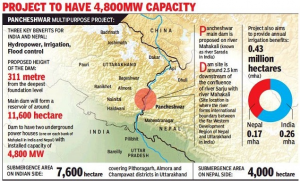
THE EXPLANATION:
- In India and Nepal, the proposed catchment area for the water is expected to submerge a total of 11600 hectares of land (7600 hectares in India and 4000 hectares in Nepal).
- This mega dam (Pancheshwar) will be built upon the Mahakali river (known in India as Sharada) which originates in Nepal and flows through Uttarakhand where various tributaries like Dhauli, Gori, Sarayu and Ramganga feed the Mahakali. Upon completion, this dam, the biggest in South Asia, is expected to generate 6480 MW of power, and will service both India and Nepal, besides controlling floods and decreasing the fear of drought.
IMPORTANCE:
- Nepal shares a border with 5 Indian states- Uttarakhand, Uttar Pradesh, West Bengal, Sikkim and Bihar. Hence an important point of cultural and economic exchange.
- Importance for India can be studied from two different angles: a) their strategic importance for India’s national security; and b) their place in India’s role perception in international politics.
- Nepal is right in the middle of India’s ‘Himalayan frontiers’, and along with Bhutan, it acts as northern ‘borderland’ flanks and acts as buffer states against any possible aggression from China.
- The two countries not only share an open border and unhindered movement of people, but they also have close bonds through marriages and familial ties, popularly known as Roti-Beti ka Rishta.
- India is Nepal’s largest trade partner and the largest source of foreign investments, besides providing transit for almost the entire third-country trade of Nepal.
- Indian firms engaged in manufacturing, services (banking, insurance, dry port), power sector and tourism industries etc.

THE PRELIMS PRACTICE QUESTIONS
QUESTION OF THE DAY
Q1. Consider the following statements about Olive Ridley Turtles:
- They are migratory species visiting Indian coasts for nesting.
- Their mass nesting phenomenon is called arribadas.
- Their IUCN conservation status is endangered.
Which of the statements given above is/are correct?
a) 1 only
b) 1 and 2 only
c) 2 and 3 only
d) 1, 2 and 3
ANSWER FOR 1ST APRIL 2022
Answer: B
Explanation:
- Statement 1 is incorrect: Koodiyattam is a traditional performing art form in the state of Kerala, India.
- Statement 2 is correct: It is a combination of ancient Sanskrit theatre with elements of Koothu, an ancient performing art from the Sangam era.
- Statement 3 is correct: It is officially recognized by UNESCO as a Masterpiece of the Oral and Intangible Heritage of Humanity.
EUROPEAN DECLARATION ON DIGITAL RIGHTS AND PRINCIPLES FOR THE DIGITAL DECADE
THE CONTEXT: The European Commission has proposed a set of digital rights and principles in January 2022 that aim to protect people’s rights, support democracy, and ensure a fair and safe online environment. The European Parliament and the Council of the European Union will discuss the proposal before its adoption. This article explains the major features of the declaration and its significance.
THE SALIENT FEATURES OF THE DECLARATION
PEOPLE AT THE CENTRE OF THE DIGITAL TRANSFORMATION:
- Technology should serve and benefit all Europeans and empower them to pursue their aspirations in full security and respect for their fundamental rights. This requires:
- Strengthening the democratic framework for a digital transformation that benefits everyone and improves the lives of all Europeans.
- Fostering responsible and diligent action by all digital actors, public and private, for a safe and secure digital environment.
SOLIDARITY AND INCLUSION:
- Everyone should have access to technology that aims at uniting and not dividing people. The digital transformation should contribute to a fair society and economy in the Union. These needs:
(a) Making sure that technological solutions respect people’s rights, enable their exercise, and promote inclusion.
(b) Developing adequate frameworks so that all market actors assume their responsibilities and make a fair contribution to the costs of public goods and services.
CONNECTIVITY, DIGITAL EDUCATION, AND SKILLS:
- Everyone, everywhere in the EU, should have access to affordable and high-speed digital connectivity. Everyone has the right to education, training, and lifelong learning and should be able to acquire all basic and advanced digital skills. This requires:
(a) Ensuring access to excellent connectivity for everyone, wherever they live and whatever their income.
(b)Promoting and supporting efforts to equip all education and training institutions with digital connectivity, infrastructure, and tools.
WORKING CONDITIONS:
- Everyone has the right to fair, just, healthy, and safe working conditions and appropriate protection in the digital environment as in the physical workplace, regardless of their employment status, modality or duration. This needs:
(a) Ensuring that everyone shall be able to disconnect and benefit from safeguards for work-life balance in a digital environment.
A fair online environment:
- Everyone should be able to effectively choose which online services to use based on objective, transparent and reliable information. This requires:
(a) Ensuring a safe, secure.
(b) A fair online environment where fundamental rights are protected, and the responsibilities of platforms, especially large players and gatekeepers, are well defined.
PARTICIPATION IN THE DIGITAL PUBLIC SPACE:
- Everyone should have access to a trustworthy, diverse, and multilingual online environment. Access to diverse content contributes to a pluralistic public debate and should allow everyone to participate in democracy. This requires:
(a) Supporting the development and best use of digital technologies to stimulate citizen engagement and democratic participation.
(b) Continuing safeguarding fundamental rights online, notably the freedom of expression and information.
PRIVACY AND INDIVIDUAL CONTROL OVER DATA:
- Everyone has the right to the protection of their data online. That right includes the control on how the data are used and with whom they are shared.
- Everyone has the right to the confidentiality of their communications and the information on their electronic devices, and no one shall be subjected to unlawful online surveillance or interception measures.
- Everyone should be able to determine their digital legacy and decide what happens with the publicly available information that concerns them after their death.
SUSTAINABILITY:
- To avoid significant harm to the environment and promote a circular economy, digital products and services should be designed, produced, used, disposed of, and recycled to minimise their negative environmental and social impact. This requires:
(a) Supporting the development and use of sustainable digital technologies that have minimal environmental and social impact.
(b) Developing and deploying digital solutions with a positive impact on the environment and climate.
SIX THEMES OF THE DECLARATION IN A NUTSHELL
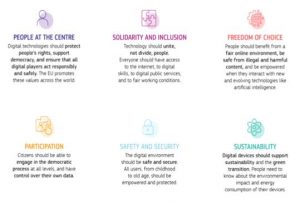
THE RATIONALE BEHIND THE EUROPEAN DECLARATION ON DIGITAL RIGHTS AND PRINCIPLES
ACCELERATION IN DIGITAL TRANSFORMATION:
- Digital transformation offers significant opportunities for a better quality of life, innovation, economic growth, and sustainability. But it also presents new challenges for the fabric, security, and stability of societies and economies.
- With the acceleration of the digital transformation, the time has for the European Union (EU) to spell out how its values and fundamental rights should be applied in the online world.
A CONTINUITY IN DATA PROTECTION APPROACHES:
- The European Parliament has made several calls for ensuring the full compliance of the Union’s approach to the digital transformation with fundamental rights such as data protection or non-discrimination and with principles such as technological and net neutrality and inclusiveness.
- It has also called for strengthened protection of users’ rights in the digital environment. This declaration is in furtherance of such initiatives and approaches.
BUILDING ON PREVIOUS INITIATIVES:
- This declaration builds on previous initiatives such as the “Tallinn Declaration on e-Government”, the “Berlin Declaration on Digital Society and Value-based Digital Government”, the “Lisbon Declaration – Digital Democracy with a Purpose”, “Path to the Digital Decade” etc. which calls for a model of digital transformation that strengthens the human dimension of the digital ecosystem with the Digital Single Market as its core.
GUIDING PRINCIPLES FOR THE MARKET:
- The declaration aims to explain shared political intentions.
- Not only does it recall the most relevant rights in the context of the digital transformation, but it also serves as a reference point for businesses and other relevant actors when developing and deploying new technologies.
FLAG POSTS FOR POLICYMAKERS:
- The democratic oversight of the digital society and economy should be further strengthened, fully respecting the rule of law principles, effective justice, and law enforcement.
- Thus, the declaration will guide policymakers when reflecting on their vision of the digital transformation: putting people at the center of the digital transformation, underlying solidarity, and inclusion, restating the importance of freedom of choice, etc.
PROMOTING BEST PRACTICES:
- The Union shall promote the declaration in its relations with other international organizations and third countries.
- The principles can serve as an inspiration for international partners to guide a digital transformation that puts people and their human rights at the center throughout the world.
A CRITICAL EVALUATION OF THE DECLARATION
- Despite the solemn character of the draft declaration, this text does not purport to exercise any legally binding role. Its ‘political nature is made explicit in the declaration itself and the accompanying communication. as the preamble recalls, it remains declaratory and, even if endorsed, will not set out legal obligations.
- The declaration has not been introduced as an EU Charter of Fundamental Rights 2.0, a document with potential constitutional value.
- The declaration does not have any direct mechanism of enforcement. The EU Commission, however, has proposed to use this document as a guide to assess the status of the digital transition across the EU in the form of an annual report.
EU PARLIAMENT AGREES ON PROPOSAL TO TAKE ON U.S. TECH GIANTS
In the European Parliament in Jan 2022 signed off on a proposal for new rules aimed at U.S. tech giants, paving the way for talks on the plan with member countries and the European Commission. The Digital Services Act, a proposal from the EU antitrust chief would force Amazon, Apple, Alphabet unit Google and Facebook owner Meta to do more to tackle illegal content on their platforms or risk fines up to 6% of global turnover. The proposal still needs to be ironed out with EU countries and lawmakers before it can become law, the first of its kind in the world. The European Parliament adopted the proposal with 530 votes in favour, 78 against, and 80 abstentions.
“With a huge majority, the European Parliament adopted the Digital Services Act. A big win, with support from the left to right,” Dutch lawmaker Paul Tang said on Twitter. Christel Schaldemose, a Danish lawmaker leading the Parliament’s negotiating team, said: “Online platforms have become increasingly important in our daily life, bringing new opportunities and new risks. We have to make sure that what is illegal offline is illegal online.” France, which holds the rotating EU presidency, aims for an agreement in the first half of 2022.
AN ANALYSIS OF THE DIGITAL RIGHTS AND PRIVACY: THE INDIAN SCENARIO
‘Digital rights’ is a broad term: it can imply the right to privacy and data protection; it can be related to trolling, online threats, and hate speech; it can address broader issues of equitable Internet access regardless of economic background and disabilities. In India, where citizens’ data are at the mercy of companies and government and where is no privacy law, the Puttaswamy judgment, and the Justice B.N. Srikrishna committee report that led to the Personal Data Protection Bill of 2019 came as a ray of hope. But the Joint Committee report on the Bill has failed to provide a robust draft of legislation ensuring the privacy of citizens.
Earlier, the Central government introduced IT Rules 2021 which is also being criticized as putting disproportionate restrictions on digital freedom. Instead, it is held that it carved out an architecture for a surveillance state. Digital marketing has resulted in the compromise of the personal data integrity of the users and such data is being exploited commercially. There are also many instances of a data breach on the part of both public and private players including the UIDAI.
The lack of accountability of the tech giants is an acute problem in India despite their huge influence on public policy and governance matters. These issues have been echoed in Parliament recently where members urged the government to end the “systematic influence and interference of Facebook and other social media giants” on electoral politics being used to “hack democracy”. Last year, Facebook (Meta)was accused of allowing algorithms to amplify hate speech. Whistle-blowers Sophie Zhang and Frances Haugen have testified against the company’s policies. Haugen told British lawmakers that the social media company stokes online hate and extremism, fails to protect children from harmful content and lacks any incentive to fix the problems.
EU, INDIA, 8 OTHER COUNTRIES CALL FOR INT’L COOPERATION ON DATA PROTECTION
In a ‘Joint Declaration on Privacy and the Protection of Personal Data: Strengthening trust in the digital environment’, the European Union, Australia, Comoros, India, Japan, Mauritius, New Zealand, South Korea, Singapore, and Sri Lanka said rapid technological developments, in particular in information and digital technologies, have brought benefits for their economies and societies, as well as new challenges for privacy and the protection of personal data.
To foster data free flow with trust, which, as also acknowledged by the G20 Rome Leaders’ Declaration, is key to harnessing the opportunities of the digital economy, it is vital to ensure, as guaranteed by these countries’ respective legal frameworks, respect for individuals’ right to privacy and the protection of personal data as a core value and fundamental freedom, said the declaration.
They called for comprehensive legal frameworks and policies covering both the private and public sectors. They underlined core principles such as lawfulness, fairness, transparency, purpose limitation, data minimisation, limited data retention, data security, and accountability. They also called for enforceable rights of individuals, such as access, rectification, deletion, and safeguards concerning automated decision-making such as transparency and the possibility to challenge the outcome.
The joint declaration emphasised safeguards for international transfers to enable cross-border data flows by ensuring that the protection travels with the data. It also called for independent oversight by a dedicated supervisory authority and effective redress.
THE WAY FORWARD
GENERATE AND SPREAD DIGITAL AWARENESS:
- Similar to many other Internet bills of rights promoted in the past few years by civil society groups and other international organisations, the EU declaration on digital rights and principles plays an important advocacy role in raising public awareness among citizens, institutions, and companies.
DEVELOP DIGITAL REGULATORY CAPABILITY:
- In a time when rapid global digital advancement consistently outpaces regulatory frameworks and institutions of State agencies in the multilateral domain, the declaration represents a unique step toward a human rights-based approach to digital governance and inclusion.
- However, they will remain mere declaratory without regulatory and governance mechanisms to enforce these rights.
A BENCHMARK FOR OTHER COUNTRIES:
- The declaration deals with very substantive aspects of the digital ecosystem including digital equality and oversight of tech companies. It provides a template for other countries/blocs so that they can streamline and update their own digital governances policies.
BALANCING THE RIGHTS OF THE MARKET, GOVERNMENT, AND CONSUMERS:
- The attempt to rein in the “Big-Tech Power” has been ongoing worldwide, including in the USA, Australia, India, etc.
- Although it is necessary to demand and enforce accountability on these companies, this should not lead to a situation of government control over citizens’ data.
- Also, the rights of the market, the free flow of data, and the development of the digital economy should not become a casualty.
LEGAL AND POLICY CERTAINTY IN INDIA:
- India requires a comprehensive digital law and policy system that integrate privacy, regulation, legitimate government control, and scope for digital entrepreneurship. The current Data Protection Bill requires serious overhauling so are the IT Act 2000 and other associated rules and policies.
THE CONCLUSION: The Declaration furthers the global conversation on digital constitutionalism, translating constitutional principles to address the challenges of the digital revolution. It reiterates that the digital world is not a lawless space: Existing fundamental rights are as valid online as they are offline. It is a good step towards promoting a safe, reliable, accountable, and equitable digital space that can benchmark other nations/groupings.
QUESTIONS:
- Comment on the salient features of the European Declaration on Digital Rights and Principles, 2022. How far do you think that they can address the problems of inequality, poor social inclusion, and lack of accountability in the digital ecosystem?
- “The European Declaration on Digital Rights and Principles, 2022 is although right in intent but lacks substance”. Critically Examine
DAILY CURRENT AFFAIRS (APRIL 01, 2022)
THE INTERNATIONAL RELATIONS
1. CHINA, SOLOMONS ISLANDS INK DRAFT OF CONTROVERSIAL SECURITY PACT
THE CONTEXT: China and the Solomon Islands have signed a draft version of a security pact that could see Chinese police and other forces take up duties in the Pacific Island nation.
THE EXPLANATION:
- A leaked document has revealed that China and the Solomon Islands are close to signing a security agreement that could open the door to Chinese troops and naval warships flowing into a Pacific Island nation that played a pivotal role in World War II.
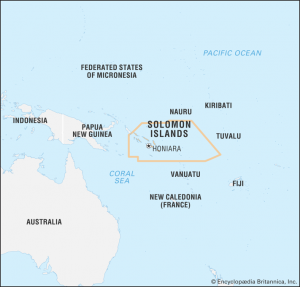
- Although it is marked as a draft and cites a need for “social order” as a justification for sending Chinese forces, it has set off alarms throughout the Pacific, where concerns about China’s intentions have been growing for years.
- The Solomon Islands, home to about 700,000 people, switched its diplomatic allegiance from Taiwan to Beijing in 2019 a contributing factor to riots in November 2021 between residents of different islands within the country.
What is the Pact?
- The leaked document states that “Solomon Islands may, according to its own needs, request China to send police, armed police, military personnel and other law enforcement and armed forces to Solomon Islands to assist in maintaining social order, protecting people’s lives and property.”
- It allows China to provide “assistance on other tasks” and requires secrecy, noting, “Neither party shall disclose the cooperation information to a third party.”
2. THE 20TH EDITION OF THE ‘VARUNA’ BILATERAL NAVAL EXERCISE
THE CONTEXT: In an effort to further strengthen Defence ties, India and France began a five-day mega naval wargame in the Arabian Sea in reflection of growing congruence in their maritime security cooperation.
THE EXPLANATION:
- The bilateral exercises between the two Navies were initiated in 1993. The exercise was christened as ‘Varuna’ in 2001 and has become a vital part of India – France strategic bilateral relationship.
- Various units including ships, submarines, maritime patrol aircraft, fighter aircraft and helicopters of the two navies are participating in the exercise. These units will endeavour to enhance and hone their operational skills in maritime theatre, augment inter-operability to undertake maritime security operations and demonstrate their commitment to promote peace, security and stability in the region as an integrated force.
- Having grown in scope and complexity over the years, Varuna series of exercises continue to provide both the navies opportunities to learn from each other’s best practices.
- The exercise has been a principal driver for operational level interactions between the two navies and has underscored the shared commitment of both nations to security, safety and freedom of the global maritime commons.
- The maritime cooperation between India and France has witnessed a major expansion in the last few years. The Indian and French navies in April last year too carried out a mega wargame in the Arabian Sea.
- The French Navy deployed its nuclear-powered aircraft carrier Charles de Gaulle, and its entire carrier strike group in that exercise, reflecting growing congruence in naval ties.
THE ECONOMIC DEVELOPMENTS
3. INDIA’S EXTERNAL DEBT ROSE TO $614.9 BILLION AT END OF DEC. 2021
THE CONTEXT: According to Finance Ministry India’s external debt rose by $11.5 billion to $614.9 billion in the three months ended December 2021.
THE EXPLANATION:
- The external debt to GDP ratio fell marginally to 20% at the end of December last year from 20.3% at the end of September 2021.
- According to India’s Quarterly External Debt Report for quarter ended December 2021, the country’s external debt was placed at $614.9 billion, recording an increase of $11.5 billion over its level at the end of September 2021.
- Valuation gains due to the appreciation of the U.S. dollar vis-a-vis major currencies such as Euro, Yen and Special Drawing Rights (SDRs) was placed at $1.7 billion.
- Commercial borrowings remained the largest component of external debt, with a share of 36.8%, followed by non-resident deposits (23.1%) and short-term trade credit.
- The share of short-term debt, with original maturity of up to one year, in total external debt increased to 18.6% at the end of December 2021 from 17.4% at end-September 2021.
- S. dollar denominated debt remained the largest component of India’s external debt, with a share of 52% at end-December 2021, followed by the Indian rupee (32%), SDR (6.7%), Yen (5.3%), and the Euro (3.1%).
- Also, the report added, “the borrower-wise classification shows that the outstanding external debt of government marginally declined while that of non-government sector increased as at end-December 2021 over the previous quarter”.
Value Addition:
What is External Debt?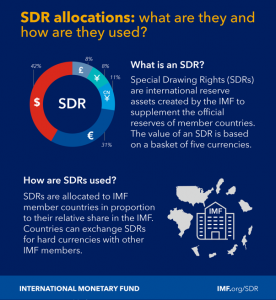
- External debt can be regarded as one of the forms of a tied loan, where the borrower needs to apply any spending of the funds to the country which has provided the loan.
- In case of an inability of the borrower country to produce and sell goods so as to make a profitable return to repay the loan, there arises a debt crisis.
- As of June 2021, India’s external debt was placed at US$ 571.3 billion, recording an increase of US$ 1.6 billion over its level at the end-March 2021.
- India’s external debt to GDP ratio declined to 20.2 per cent at the end-June 2021 from 21.1 per cent at end-March 2021.
- External debt sustainability can be measured based on the following parameters:
- Government’s debt and current fiscal revenue ratio.
- The overall share of short and long-term debt in the total debt burden.
- Share of concessional debt.
- Foreign debt to exports ratio
- Debt to GDP ratio
- The share of external debt to the total debt of the country.
THE ENVIRONMENT, ECOLOGY AND CLIMATE CHANGE
4. DOLPHIN COUNT SURGES IN GAHIRMATHA, DIPS IN CHILIKA
THE CONTEXT: According to the Annual Dolphin Census, the population of the dolphin along Odisha’s coast and in its water bodies has increased but the number of Irrawaddy dolphins in Chilika lake has fallen.
THE EXPLANATION:
- The report stated that Gahirmatha is home to the State’s largest population of dolphins, even more than Chilika.
- As per the 2022 dolphin census, Gahirmatha Marine Sanctuary and nearby areas in Bhitarkanika saw dolphin count skyrocket to 540 from 342 last year. These included 45 Irrawaddy , 135 ottlenose, 332 humpback, 13 striped and 15 spinner dolphins.
- In the 2021 census, forest officials sighted only 342 dolphins including 39 Irrawaddy, 22 bottlenose and 281 humpback dolphins. Dolphins are commonly sighted in water bodies in Khola, Nalitapata, Dhamara and in the sea near Satabhaya, Pentha, Agaranashi, Eakakula, Hukitola and other areas within the sanctuary.
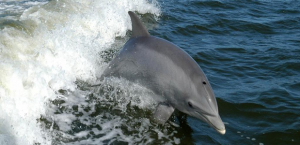
- However, the count of dolphins in Chilika Wildlife Division saw a dip from 188 in 2021 to 167 in 2022.
Value Addition:
- Dolphins have been included in Schedule I of the Indian Wild Life (Protection) Act 1972, in Appendix I of the Convention on International Trade in Endangered Species (CITES), in Appendix II of the Convention on Migratory Species (CMS) and categorised as ‘Endangered’ on the International Union for the Conservation of Nature’s (IUCN) Red List.
THE INTERNAL SECURITY AFFAIRS
5. CENTRE REDUCES DISTURBED AREAS UNDER AFSPA IN 3 NORTH EAST STATES
THE CONTEXT: According to the Ministry of Home Affairs (MHA), AFSPA is being removed from 15 police station areas in seven districts of Nagaland; 15 police station areas in six districts of Manipur; and 23 districts entirely and one district partially in Assam.
THE EXPLANATION:
- After Assam and Meghalaya resolved a part of their 50-year boundary dispute in the Centre’s push for a “dispute-free Northeast”, Union Home Minister announced that the Armed Forces Special Powers Act (AFSPA) will be removed from several districts across Assam, Nagaland, and Manipur.
- According to the Ministry of Home Affairs (MHA), AFSPA is being removed from 15 police station areas in seven districts of Nagaland; 15 police station areas in six districts of Manipur; and 23 districts entirely and one district partially in Assam.
- The decision comes in the backdrop of vociferous demands for AFSPA to be lifted after six civilians were gunned down in Nagaland’s Mon district last December in a botched operation by security personnel. Seven more civilians and security personnel died in the retaliatory violence that followed, prompting the Nagaland Assembly to pass a resolution for the repeal of AFSPA.
- However, Mon district remains a “disturbed area since this is a border district and has a strong presence of NSCN-K (YA),” said sources in the Nagaland government.
- The notification of “disturbed areas” under AFSPA has been in force in Assam since 1990, in Nagaland since 1995, and in Manipur, except the Imphal Municipality area, since 2004. Starting in 2015, the Government removed AFSPA entirely from Tripura and Meghalaya, and partially from Arunachal Pradesh, which currently has three districts and two police station areas in a fourth district under the Act.
- In Assam, AFSPA will remain in the districts of Karbi Anglong, West Karbi Anglong, Dima Hasao, Dibrugarh, Tinsukia, Charaideo, Sivasagar, Golaghat, Jorhat and the Lakhipur subdivision of Cachar.
Demands to repeal AFSPA
- Anger over the incident is rising in Nagaland, where people have frequently accused security forces of wrongly targeting innocent locals in counterinsurgency operations against rebel groups under the Armed Forces Special Powers Act (AFSPA).
- Besides sweeping powers of search and arrest, the law, enforced in parts of four of the seven northeastern states as well as Indian-administered Kashmir, allows Indian forces to open fire to maintain public order in areas designated as “disturbed areas”.
- Nagaland is covered by the law as India says rebel groups operate from thick jungles of an unfenced region that also spans the neighbouring states of Manipur and Arunachal Pradesh, which border Myanmar.
What is Armed Forces Special Powers Act (AFSPA)?

How is a region declared ‘disturbed’?
Section (3) of the AFSPA empowers the governor of the state or Union territory to issue an official notification in The Gazette of India, following which the Centre has the authority to send in armed forces for civilian aid.
- Once declared ‘disturbed’, the region has to maintain the status quo for a minimum of three months, according to The Disturbed Areas (Special Courts) Act, 1976.

Criticism of AFSPA:
Sec 4(a) in which army can shoot to kill, as it violates article 21 which gives the right to life.
- Section 4(b) search without warrants violates the right to liberty and article 22.
- Dispersion of civil assembly by armed forces under section 121 violates the right to assembly
- No judicial magistrate permission required while arresting –violate article 22
- Overrides CrPC.
- Violation of human rights
- It alienates the people from the army and then from the rest of India. A feeling of otherworldliness is generated in their mind.
What should be done?
- Create committees at the district level with representatives of the army, administrators and the public which will report, assess and track complaints in that area.
- All investigations should be time-bound reasons for the delay must be communicated with the aggrieved.
- Amendments In-Laws: The lacunae in the Act, as a result of definitional voids with respect to terms like “disturbed”, “dangerous” and “land forces” need to be amplified to ensure greater clarity.
- The onus of proving the alleged person as a terrorist should lie with the forces. Sec 7 should be suitably amended to this effect.
SCHEMES & INITIATIVES IN NEWS
6. CJI INTRODUCES ‘FASTER’ SYSTEM
The Context: The Chief Justice of India has introduced the “Fast and Secured Transmission of Electronic Records” (FASTER) system.
About ‘FASTER’ System:
- The ‘Fast and Secured Transmission of Electronic Records’ (FASTER) software transmits court orders swiftly and securely through electronic mode, ensuring quicker communication of judicial orders.
- It also proposed that the e-authenticated copies of the record of proceedings/orders, digitally signed by the authorized officer may be transmitted through FASTER system to the duty-holders of the justice system.
Need:
- There have been cases where the jail inmates are not released despite bail orders passed by the court due to delays in communication of such orders. So, it was needed to utilize information and communication technology tools for efficient transmission of court orders.
Significance:
- Ensure that undertrials are not made to wait for days on end behind bars to be released because the certified hard copies of their bail orders took time to reach the prison.
- Undertrials are the people who are yet to be found guilty of the crimes they have been accused of.
- Prevent unnecessary arrests and custody of people even after the court had already granted them its protection.
- Communicate a stay on an execution ordered by the final court on time.
Challenges:
- The availability of internet connection in jails across the nation as without this facility transmission of such orders to prisons will not be possible.
- Awareness and training to jail officials about the use of digital technology.
THE PRELIMS PRACTICE QUESTIONS
QUESTION OF THE DAY
Q1. Consider the following statements about Koodiyattam:
- It is a traditional performing art form in the state of Tamil Nadu, India.
- It has elements of Koothu, an ancient performing art from the Sangam era.
- It is officially recognized by UNESCO as a Masterpiece of the Oral and Intangible Heritage of Humanity.
Which of the statements given above is/are correct?
a) 1 and 2 only
b) 2 and 3 only
c) 3 only
d) 1, 2 and 3
ANSWER FOR 31ST MARCH 2022
Answer: C
Explanation:
- Project NETRA is an initiative by the Indian Space Research Organisation (ISRO) which is an early warning system in space to detect debris and hazards to Indian satellites.
- Under this project, the Indian space organization plans to put up many observational facilities like telescopes, connected radars, data processing units, and a control center.
Day-175 | Daily MCQs | UPSC Prelims | MODERN HISTORY OF INDIA
[WpProQuiz 191]
ECONOMIC SURVEY 2021-22: CHAPTER 10- SOCIAL INFRASTRUCTURE AND EMPLOYMENT
THE INTRODUCTION: The need for a strong and resilient social infrastructure became even more important during the ongoing COVID-19 pandemic that brought into focus the vulnerabilities in social infrastructure across countries. Specifically, the pandemics posed the challenge of balancing livelihoods while saving lives. To save lives and livelihoods amidst the COVID crisis, countries have adopted various strategies. India, the country with the second-largest population and a large elderly population, adopted a multi-pronged approach. The government’s response through ‘Aatmanirbhar Bharat Abhiyan’ packages and other sector-specific initiatives have provided the necessary support to mitigate the adverse impact of a pandemic. This chapter gives a brief account of India’s response to Social Infrastructure and Employment.
INDIA’S HEALTH RESPONSE TO THE COVID-19
Like most other countries, India also faced two COVID-19 waves: the first in 2020 and the second in 2021. To save lives, the Government adopted a multi-pronged approach viz.
- Restrictions/partial lockdowns,
- Building capacity in health infrastructure,
- COVID-19 appropriate behavior, testing, tracing, treatment
- Vaccination drive.
COVID VACCINATION STRATEGY
- Guided by scientific and epidemiological evidence, World Health Organisation (WHO) guidelines, and global best practices, India’s National COVID Vaccination Program has been one of the world’s largest vaccination programs.
- Government of India procured 75 percent of monthly vaccine production and provided it free to States and UTs, while the rest could be procured by private hospitals.
- Availability of Vaccine: The ICMR funded the clinical trials of the COVISHIELD vaccine developed in collaboration with Oxford – Astra Zeneca. COVISHIELD and COVAXIN have been widely used vaccines in India. Every month about 250- 275 million doses of COVISHIELD and 50-60 million doses of COVAXIN have been produced.
- Pricing and equity: At all Government COVID-19 Vaccination Centres (CVCs), the COVID-19 vaccine was made available free of cost for all eligible citizens.
- Coverage: From 1st May 2021, all 94 crore persons of age 18 years and above, were made eligible for COVID vaccination. From 3rd January 2022, COVID-19 vaccine coverage has been extended to the age group of 15-18 years. Till 19th January 2022, 3.73 crore youngsters between 15-18 age group have been vaccinated with 1st dose of COVID-19 vaccine covering more than 50 percent of youngsters.
- Vaccine hesitancy: To reduce vaccine hesitancy, the Government made efforts that include awareness by identified experts. From 3rd November 2021, a campaign, ‘Har Ghar Dastak’, has been initiated to identify and vaccinate those who missed 1st dose and are due for 2nd dose through house-to-house mobilization activity.
- Technology-driven: Arogya Setu mobile app was launched to enable people to assess the risk of their catching the COVID-19 infection.
- Vaccination Progress: As of 16th January 2022, a total of 156.76 crore doses of COVID-19 vaccines have been administered: 90.75 crores first dose and 65.58 crores second dose.
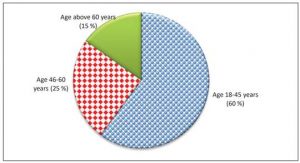
Population vaccinated by country (in percent)
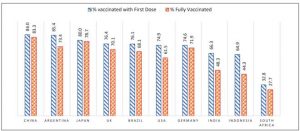
TRENDS IN SOCIAL SECTOR EXPENDITURE
- Government’s spending on social services increased significantly during the pandemic. In 2021-22 (BE), Centre and State governments earmarked an aggregate of ` 71.61 lakh crore for spending on the social service sector; an increase of 9.8 percent over 2020-21.
- Last year’s (2020-21) revised expenditure has also gone up by ` 54,000 crores from the budgeted amount. In 2021-22 (BE), funds to the sector increased to 8.6 percent of Gross Domestic Product (GDP) (8.3 percent in 2020-21).
- During the last five years, social services accounted for about 25 percent of the total Government expenditure (Centre and States taken together). In 2021-22 (BE), it was 26.6 percent.
- Expenditure in the health sector increased from ` 2.73 lakh crore in 2019-20 (pre-COVID-19) to ` 4.72 lakh crore in 2021-22 (BE), an increase of nearly 73 percent.
- Union Budget 2021-22, announced Ayushman Bharat Health Infrastructure Mission, a new Centrally Sponsored Scheme, with an outlay of about ` 64,180 crores in the next five years to develop capacities of primary, secondary, and tertiary care Health Systems
- Union Budget 2021-22 provided an outlay of Rs 35,000 crore towards COVID-19 vaccination.
- The National Health Policy, 2017 envisaged increasing the government’s health expenditure to 2.5 percent of GDP by 2025.
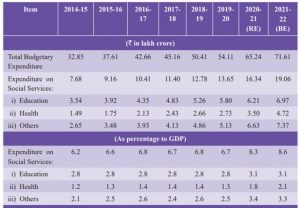
EDUCATION
- During initial COVID-19 restrictions, as a precautionary measure to protect the students from COVID-19, schools, and colleges were closed across India. This posed a new challenge for the Government in terms of continuity of education.
- School Infrastructure An assessment for the pre-pandemic year of 2019-20 for which data is available reveals that the number of recognized schools & colleges continued to increase between 2018-19 and 2019-20, except for primary & upper primary schools.
SCHOOL INFRASTRUCTURE
- An assessment for the pre-pandemic year of 2019-20 for which data is available reveals that the number of recognized schools & colleges continued to increase between 2018-19 and 2019-20, except for primary & upper primary schools.

- Toilets (girls or boys), drinking water, and hand-washing facilities are now available in most Government schools (10.32 lakh).
- Priority to drinking water and sanitation in schools under Jal Jeevan Mission, Swachh Bharat Mission as well as under Samagra Shiksha Scheme has been instrumental in providing required resources and creating these assets in schools.
- As of 19.01.2022, under Jal Jeevan Mission 8,39,443 schools were provided a tap water supply.
- Availability of teachers, measured by Pupil-Teacher Ratio, an indicator whose decrease signals improvement in quality of education, has improved at all levels continuously from 2012-13 to 2019-20: from 34 to 26 at primary, 23 to 18 at upper primary, 30 to 18 at secondary, and 39 to 26 at the higher secondary level.
Schools with Basic Facilities
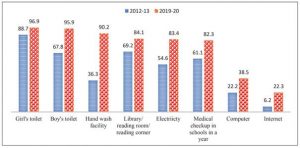
SCHOOL ENROLMENT
- In 2019-20, 26.45 crore children were enrolled in schools. During the year, schools enrolled about 42 lakh, additional children, out of which 26 lakh were in primary to higher secondary levels and 16 lakh were in pre-primary as per the Unified District Information System for Education plus (UDISE+) database.
- The enrollments increased across all levels viz., upper-primary, secondary, and higher secondary, except for the primary level. At the primary level, enrollment reduced from 13.5 crores in 2012-13 to 12.2 crores in 2019-20. This decline in enrollment was because of a decline in the total number of children in the age group 6-10 years.
School Gross Enrollment Ratios in India (in percent)

SCHOOL DROP-OUT
- the years 2019-20 saw a decline in dropout rates at primary, upper-primary, and secondary levels. In 2019-20, the school dropout rate at the primary level declined to 1.45 percent from 4.45 percent in 2018-19.
- ASER found that despite the pandemic, enrollment in the age cohort of 15-16 years continued to improve as the number of not enrolled children in this age group declined from 12.1 percent in 2018 to 6.6 percent in 2021.
Major Initiatives for Students during the COVID-19 pandemic
PM e-VIDYA: Major components
- One Nation, One Digital Education (DIKSHA) Platform
- One Class, One TV channel through Swayam Prabha TV Channels
- Extensive use of Radio, Community Radio, and Podcasts
- One DTH channel is being operated specifically for hearing impaired students in sign language.
National Digital Education Architecture (NDEAR): A digital infrastructure for Education, was launched on 29th July 2021.
Vidyanjali: To connect the Government and Government aided schools through a community/ volunteer management program.
Major Schemes for School Education during 2021-22
- Samagra Shiksha Scheme has been continued for a period of five years, from 2021-22 to 2025-26.
- NIPUN Bharat Mission: On 5th July 2021, the government launched a National Mission on Foundational Literacy and Numeracy called “National Initiative for Proficiency in Reading with Understanding and Numeracy (NIPUN Bharat)”.
- Pradhan Mantri Poshan Shakti Nirman (PM POSHAN) Scheme: The Scheme, earlier known as the ‘National Programme for Mid-Day Meal in Schools”, covers all school children studying in Balvatika (just before class I) and Classes I-VIII in Government and Government-Aided Schools.
HIGHER EDUCATION
- Gross enrollment ratio in higher education was recorded at 27.1 percent in 2019-20, slightly higher than 26.3 percent in 2018-19. For males, it has also increased from 26.3 percent in 2018-19 to 26.9 percent in 2019-20 while for females it has increased from 26.4 percent to 27.3 percent respectively.
Gross Enrollment Ratios in Higher Education for age 18-23 years (in percent)
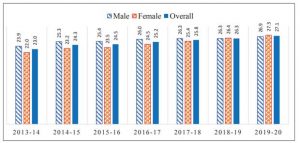
SKILL DEVELOPMENT
- To unlock the demographic dividend, several steps have been taken to increase the skill levels in the population. Periodic Labour Force Survey (PLFS) 2019-20 shows that formal vocational/technical training among youth (age 15-29 years) and working population (age 15-59 years) have improved in 2019-20 over 2018-19.
- The improvement in skills has also been for males and females, both in rural and urban sectors. However, formal training for males and females is lower in rural than in urban areas.
- As per the report of the first quarter (April-June, 2021) of the Quarterly Employment Survey (QES) in respect of establishments employing at least 10 workers in major nine sectors, 17.9 percent of estimated establishments were imparting formal skill training.
SKILL INDIA MISSION
- Launched in 2015, Skill India Mission focuses on re-skilling and up-skilling in prominent trades. Under the Mission, the government implements Pradhan Mantri Kaushal Vikas Yojana (PMKVY), Jan Shikshan Sansthan (JSS) Scheme, and National Apprenticeship Promotion Scheme (NAPS), for providing short term Skill Development training and Craftsman Training Scheme (CTS), for long term training, to the youth.
Pradhan Mantri Kaushal Vikas Yojana (PMKVY)
- PMKVY has two training components, viz., Short Term Training (STT) and Recognition of Prior Learning (RPL). Between 2016-17 and 2021-22 (as of 15 January 2022 ), under PMKVY 2.0 about 1.10 crore persons were trained (inclusive of the placement-linked and non-placement-linked components of the PMKVY).
Jan Shikshan Sansthan (JSS) Scheme
- JSS aims to provide vocational skills to non-literate, neo-literates, persons with a rudimentary level of education up to 8th and school dropouts up to 12th standard in the age group of 15-45 years. The priority groups are women, SC, ST, minorities, Divya Gyan, and other backward sections of the society.
National Apprenticeship Promotion Scheme (NAPS)
- This Scheme promotes apprenticeship training and the engagement of apprentices by providing financial support to industrial establishments undertaking apprenticeship programs under The Apprentices Act, 1961. As of 31 October 2021, 4.3 lakh apprentices are engaged under the scheme.
Craftsmen Training Scheme (CTS)
- CTS is for providing long-term training in 137 trades through 14,604 Industrial Training Institutes (ITIs) across the country. For session 2020, 13.36 lakh trainees were enrolled.
TRENDS OF EMPLOYMENT
In the absence of high-frequency data on labour market indicators, other proxies such as subscriptions to the EPFO scheme and demand for work under MGNREGA, have been used to analyze the more recent trends in employment in urban and rural sectors.
Trends in Urban employment using Quarterly PLFS data
- In the first quarter of 2020-21, the unemployment rate for the urban sector rose to 20.8 percent. The LFPR and WPR in the urban sector also declined significantly during this quarter.

- The UR gradually declined during this period to reach 9.3 percent in Q4 of 2020-21. The UR for males as well as females, aged 15 & above, recovered to the pre-pandemic levels.
TRENDS IN DATA ON DEMAND FOR WORK UNDER MGNREGS
- During the nationwide lockdown, the aggregate demand for MGNREGS work peaked in June 2020, and has thereafter stabilized.
- During the second COVID wave, demand for MGNREGS employment reached the maximum level of 4.59 crore persons in June 2021. Nonetheless, after accounting for seasonality, the demand at an aggregate level still seems to be above the pre-pandemic levels of 2019.
- For some states like Andhra Pradesh and Bihar, the demand for work under MGNREGS has reduced to below the pre-pandemic levels during the last few months.
- Intuitively, one may expect that higher MGNREGS demand may be directly related to the movement of migrant labouri. e. source states would be more impacted. Nevertheless, state-level analysis shows that for many migrant source states like West Bengal, Madhya Pradesh, Odisha, Bihar, the MGNREGS employment in most months of 2021 has been slower than the corresponding levels in 2020.
- In contrast, the demand for MGNREGS employment has been higher for migrant recipient states like Punjab, Maharashtra, Karnataka, and Tamil Nadu for most months in 2021 over 2020.
Long-term trends in employment using annual PLFS data
- During the Periodic Labour Force Survey (PLFS) 2019-20 (survey period from July 2019 to June 2020), employment at its usual status continued to expand. Between 2018-19 and 2019-20, about 4.75 crore additional persons joined the workforce.
- This is about three times more than the employment created between 2017-18 and 2018-19.
POLICY RESPONSES TO BOOST RURAL LIVELIHOOD
Incentives for job creation: Aatmanirbhar Bharat Rojgar Yojana (ABRY) was announced as a part of the Aatmanirbhar Bharat 3.0 package to boost the economy, increase the employment generation in the post-Covid recovery phase, and incentivize the creation of new employment along with social security benefits and restoration of loss of employment during COVID-19 pandemic.
Wage employment: To boost employment and livelihood opportunities for returnee migrant workers, Garib Kalyan Rojgar Abhiyaan was launched in June 2020. It focused on 25 target-driven works to provide employment and create infrastructure in the rural areas of 116 districts of 6 States with a resource envelope of Rs 50,000 crore.
Boosting Self-employment:
- The program targets to mobilize about 9-10 crore households into Self Help Groups (SHGs).
- Till December 2021, 8.07 crore households are mobilized into SHGs.
Social protection:
- Pradhan Mantri Shram Yogi Maan-Dhan (PM-SYM) Yojana, launched on 05.03.2019, is a voluntary and contributory pension scheme for providing a monthly minimum assured pension of ` 3000 upon attaining the age of 60 years.
- As of 17.01.2022, the enrollment under the PMSYM scheme is 46.09 lakh persons, out of which female enrollment was 23.89 lakh and male enrollment was 22.20 lakh.
e-SHRAM Portal
- e-SHRAM portal has been launched to create a National Database of Unorganized Workers (UWs). One of the main objectives of this portal is to facilitate the delivery of Social Security Schemes to the workers. This database is seeded with Aadhaar and for the age group between 16-59 years.
- It includes construction workers, migrant workers, gig workers, platform workers, agricultural workers, MGNREGA workers, fishermen, milkmen, ASHA workers, Anganwadi workers, street vendors, domestic workers, rickshaws pullers, and other workers engaged in similar other occupations in the unorganized sector.
Status of Labour Reforms
- In 2019 and 2020, 29 Central Labour laws were amalgamated, rationalized, and simplified into four labor codes, viz., the Code on Wages, 2019 (August 2019), the Industrial Relations Code, 2020, the Code on Social Security, 2020, and the Occupational Safety, Health & Working Conditions Code, 2020 (September 2020).
- The new laws were in tune with the changing labour market trends and at the same time accommodated the minimum wage requirement and welfare needs of the unorganized sector workers.
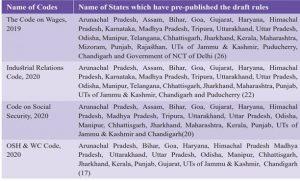
HEALTH
PROGRAMMES AND SCHEMES FOR THE HEALTH SECTOR
- Ayushman Bharat Health and Wellness Centres (AB-HWCs): The vision of Ayushman Bharat is to achieve universal health coverage. It adopts a continuum of care approach, comprising two inter-related components. The first component is the creation of 1,50,000 Health and Wellness Centres (HWCs) which cover both, maternal and child health services and non-communicable diseases, including free essential drugs and diagnostic services.
- Ayushman Bharat Pradhan Mantri Jan Arogya Yojana (AB-PMJAY): The scheme provides a health cover of ` 5 lakhs per family per year for secondary and tertiary care hospitalization to over 10.74 crores of poor and vulnerable families in the bottom 40 percent of the Indian population.
- PM-Ayushman Bharat Health Infrastructure Mission (PM-ABHIM) is a mission to develop the capacities of primary, secondary, and tertiary care health systems, strengthen existing national institutions, and create new institutions, to cater to the detection and cure of new and emerging diseases. It is the largest pan-India scheme for public health infrastructure since 2005.
- Pradhan Mantri Swasthya Suraksha Yojana (PMSSY) is being implemented to correct regional imbalances in the availability of affordable reliable tertiary healthcare services and to augment facilities for quality medical education in the country.
- Ayushman Bharat Digital Mission (ABDM), erstwhile National Digital Health Mission (NDHM), announced on 27th September 2021 to develop the backbone necessary to support the integrated digital health infrastructure of the country.
- e-Sanjeevani: In wake of the COVID-19 pandemic, the Ministry of Health and Family Welfare upgraded the thee-Sanjeevani application to enable patient-to-doctor teleconsultation to ensure a continuum of care and facilitate health services to all citizens in the confine of their homes free of cost.
HEALTH OUTCOME INDICATORS
As per the latest National Family Health Survey (NFHS)-5, social indicators such as total fertility rate, sex ratio, and health outcome indicators viz., infant mortality rate, under-five mortality rate, institutional birth rates have improved over the year 2015-16.
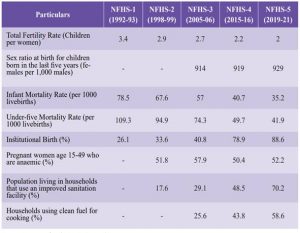
CHILD HEALTH INDICATORS
- All child nutrition indicators have also improved at all Indian levels. Under Five Mortality Rate (U5MR) has declined from 49.7 in 2015-16 to 41.9 in 2019-21. Infant Mortality Rate (IMR) has declined from 40.7 per 1000 live births in 2015-16 to 35.2 per 1000 live births in 2019-21.
- Stunting has declined from 38 percent in 2015-16 to 36 percent in 2019-21. Wasting has also declined from 21 percent in 2015-16 to 19 percent in 2019-21. And, underweight declined from 36 percent in 2015-16 to 32 percent in 2019-21.
LIFE EXPECTANCY
- Life expectancy at birth was 69.4 years for the period 2014-18; it has increased by 0.4 years from 2013-17. It varies widely across states; ranging from the lowest at 65.2 years in Chhattisgarh to the highest at 75.3 years in Kerala and Delhi. It is higher in urban areas (72.6 years) than in rural areas (68.0 years).
DRINKING WATER AND SANITATION
JAL JEEVAN MISSION (JJM)
- In 2019, out of about 18.93 crore families in rural areas, about 3.23 crore (17 percent) rural families had tap water connections in their homes. As of 2 January 2022, 5,51,93,885 households have been provided with a tap water supply since the start of the mission.
- Six states/ Uts have achieved the coveted status of 100 percent households with tap water supply, namely Goa, Telangana, A & N Islands, Puducherry, Dadra, Nagar Haveli, Daman and Diu, and Haryana.
SWACHH BHARAT MISSION (GRAMEEN) [SBM-G]
- During 2021-22 (as of 25.10.2021) a total of 7.16 lakh Individual household latrines for new emerging households and 19,061 Community Sanitary Complexes have been constructed. Also, 2,194 villages have been declared as ODF Plus.
- As per the recently released findings of the fifth round of the National Family Health Survey, 2019-21 (NFHS-5), the population living in households that use an improved sanitation facility has increased from 48.5 percent in 2015-16 to 70.2 percent in 2019-21.
ELECTRICITY AND CLEAN COOKING FUEL
- As per NFHS-5, 58.6 percent of households were using clean fuel for cooking in 2019-21, a significant increase from 43.8 percent in 2015-16.
RURAL DEVELOPMENT
PRADHAN MANTRI AWAAS YOJANA-GRAMIN (PMAY-G)
- In the first phase from 2016-17 to 2018-19, one crore houses were taken up. Under phase II, assistance is being provided for the construction of the remaining 1.95 crore houses from 2019-20 to 2021-22.
- As of 18th January 2022, 2.17 crore houses have been sanctioned and 1.69 crore houses completed against a target of 2.63 crore houses till 2021-22.
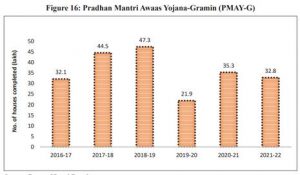
PRADHAN MANTRI GRAM SADAK YOJANA (PMGSY)
- As of 18.01.2022, a total of 1,82,506 roads measuring 7,82,844 km and 9,456 Long Span Bridges (LSBs) have been sanctioned and 1,66,798 roads measuring 6,84,994 km and 6,404 LSBs have been completed.
- World Bank (2019) in an evaluation of the scheme found that PMGSY roads had a positive impact on human capital formation in rural India.
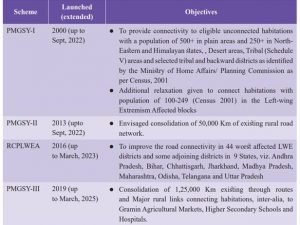
MULTIDIMENSIONAL POVERTY (MPI)
- Using the NFHS-4 (2015-16) report, in line with the global Multidimensional Poverty Index (MPI), NITI Aayog prepared Multidimensional Poverty Index at the national, for all states and districts of India.
- It will enable measuring deprivation across twelve indicators at the national, state, and districts level. In 2015-16, 25 percent of households were found to be multidimensional poor in India.
- Among states, Bihar had the largest (51.91%) multidimensional poor households, followed by Jharkhand (42.16%), Uttar Pradesh (37.79%), Madhya Pradesh (36.65%), Assam (32.67%), and Rajasthan (39.46%).
- Since the MPI index is based on NFHS-4 data of 2014-15, it may serve as the baseline for measuring deprivation in future studies.